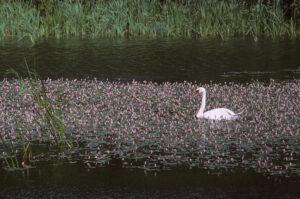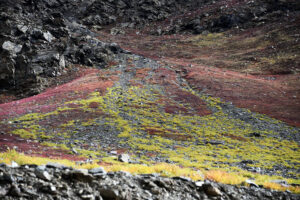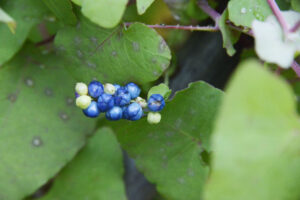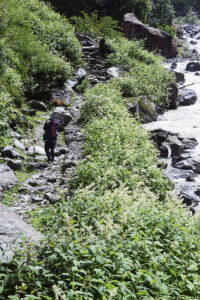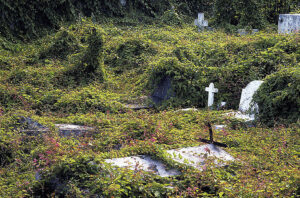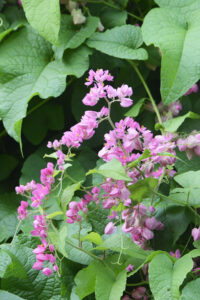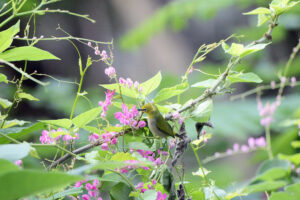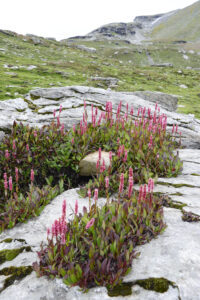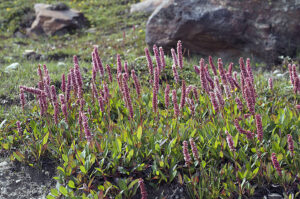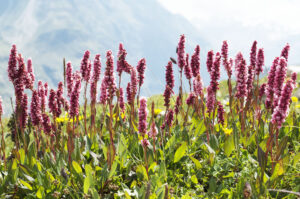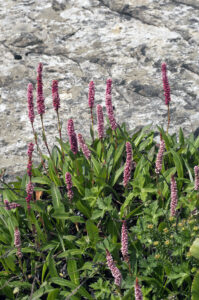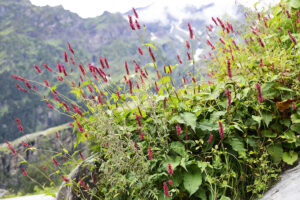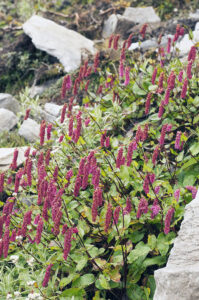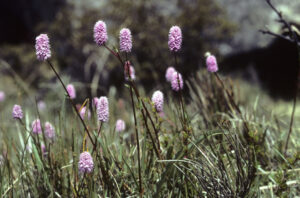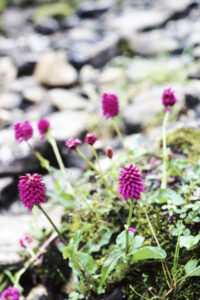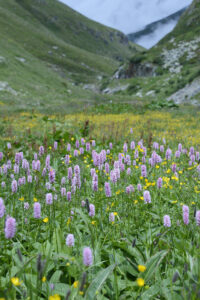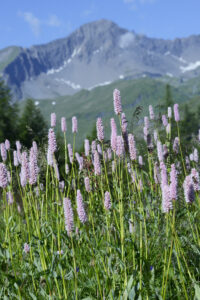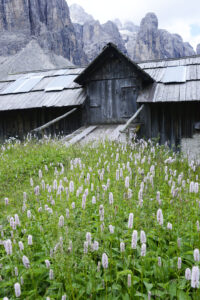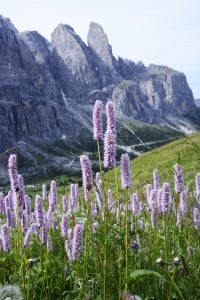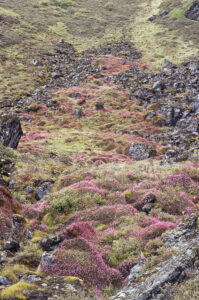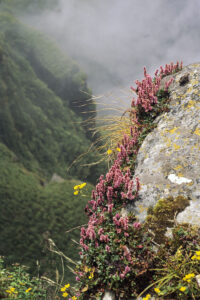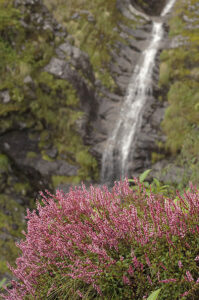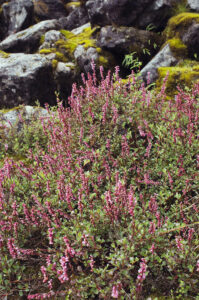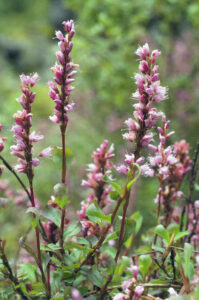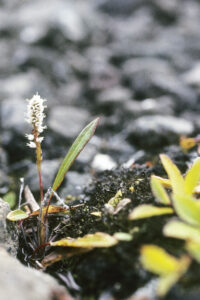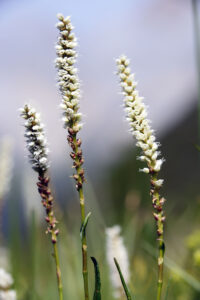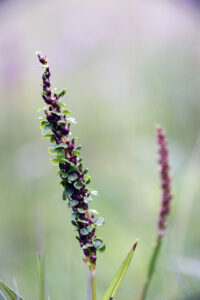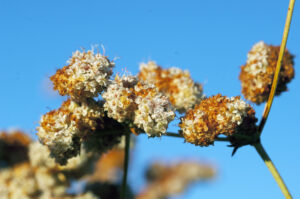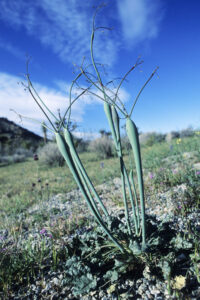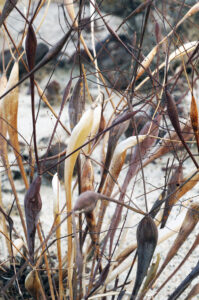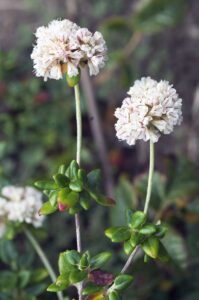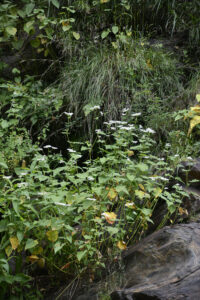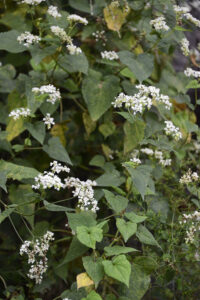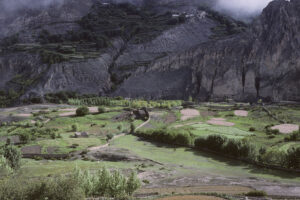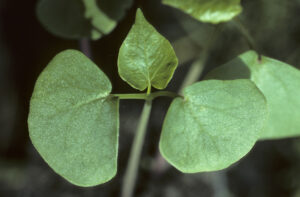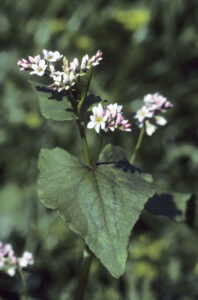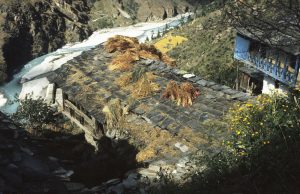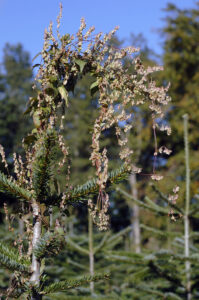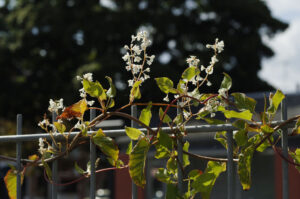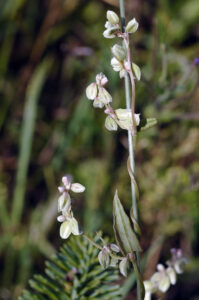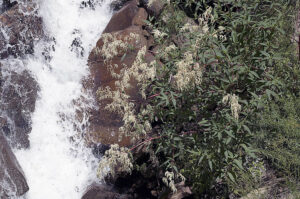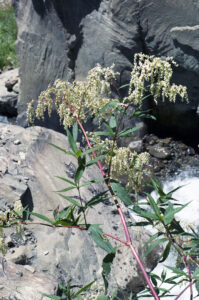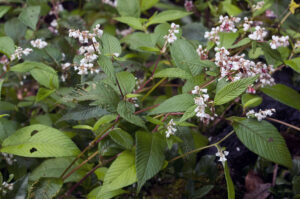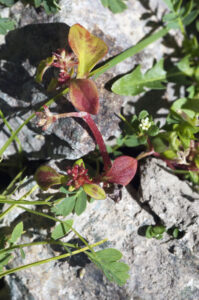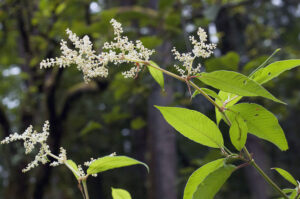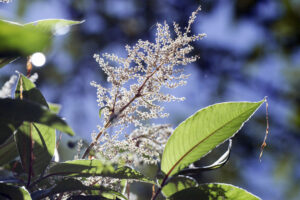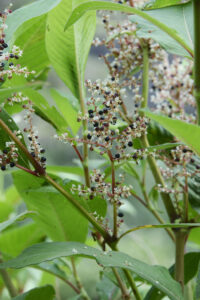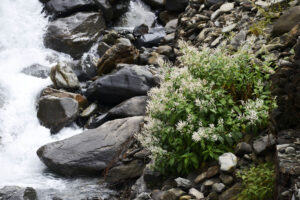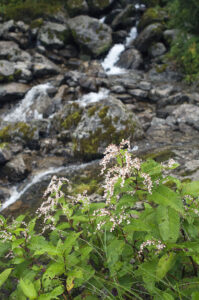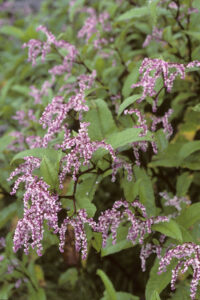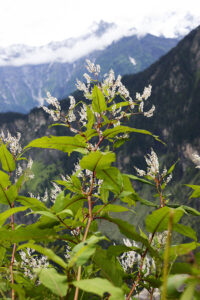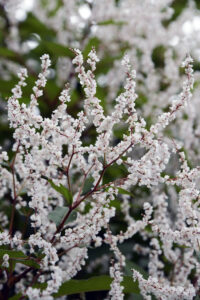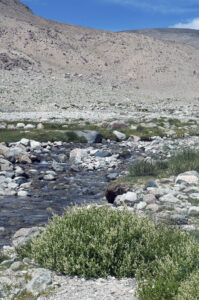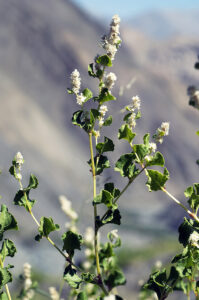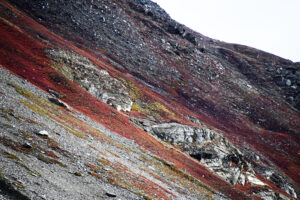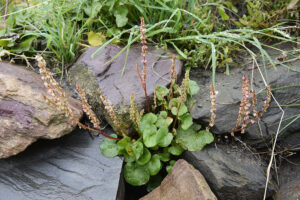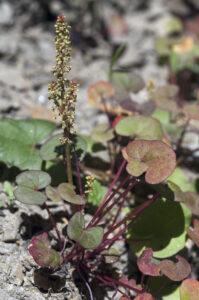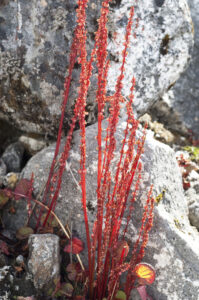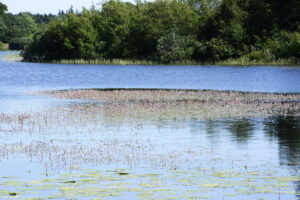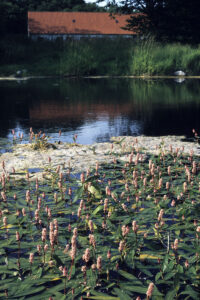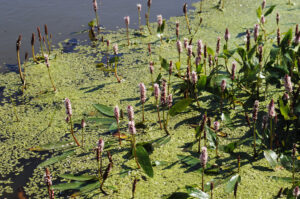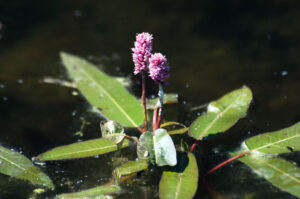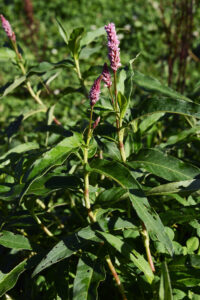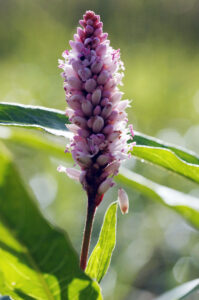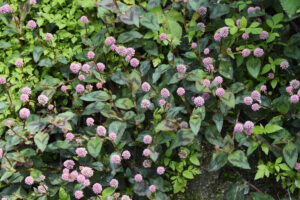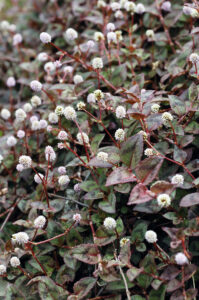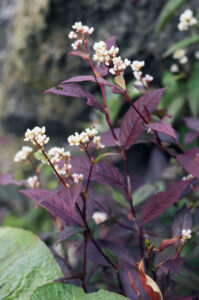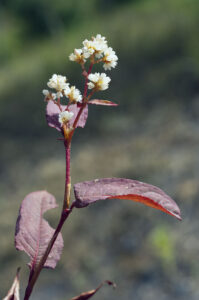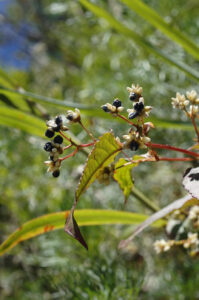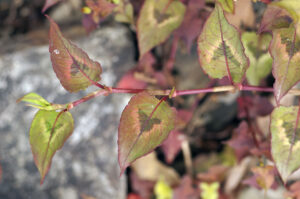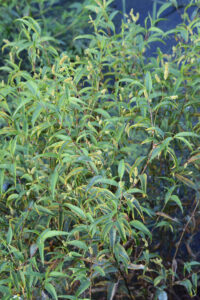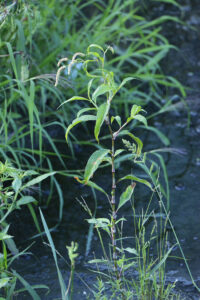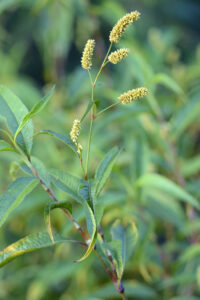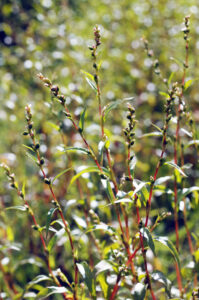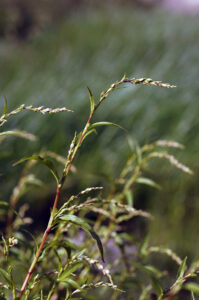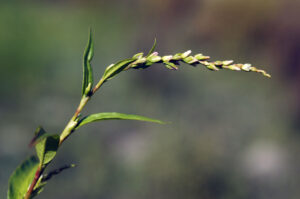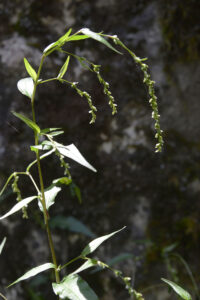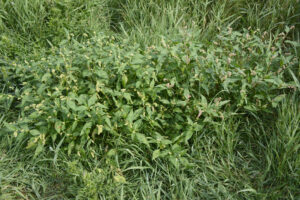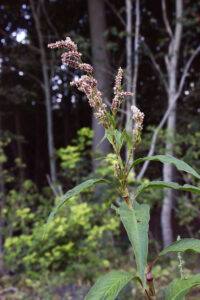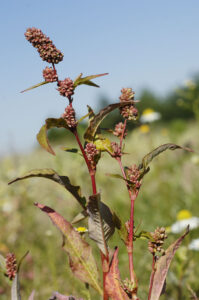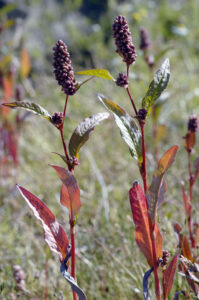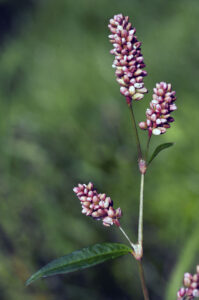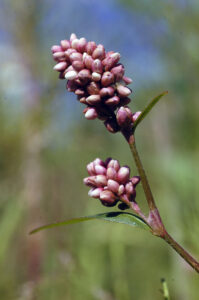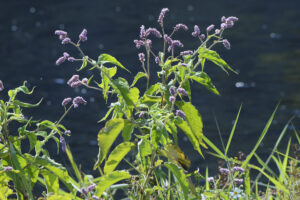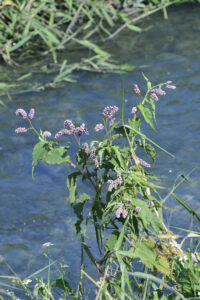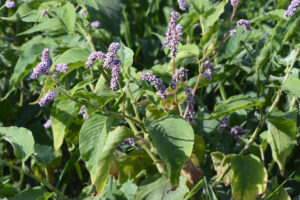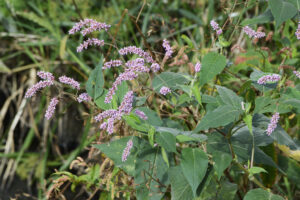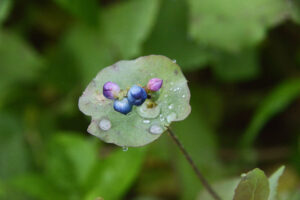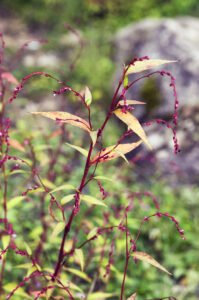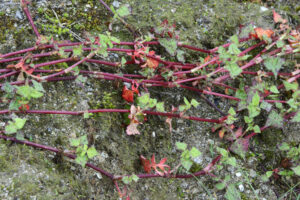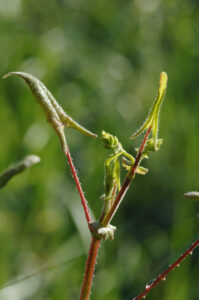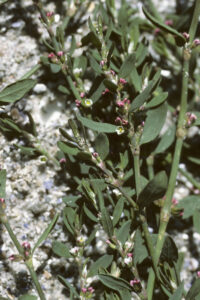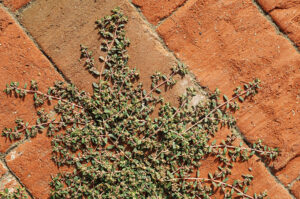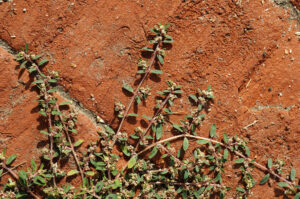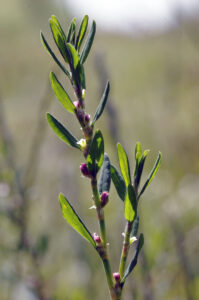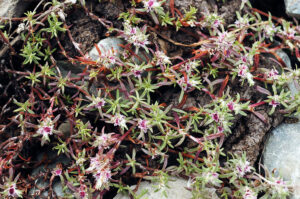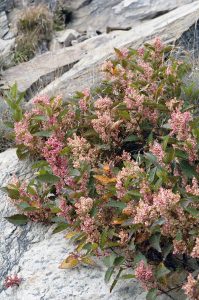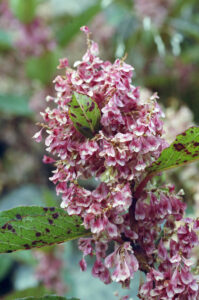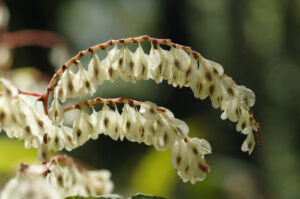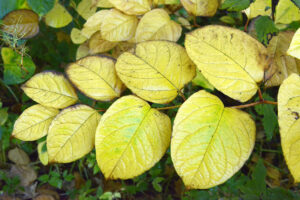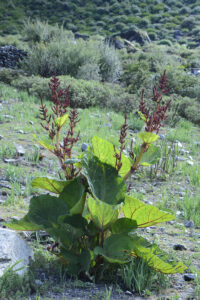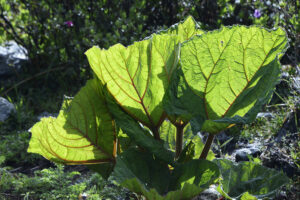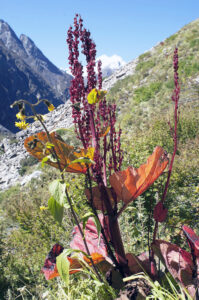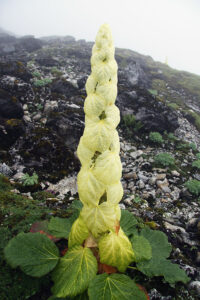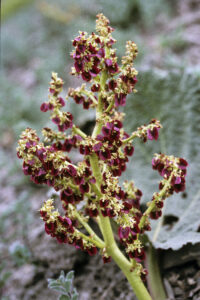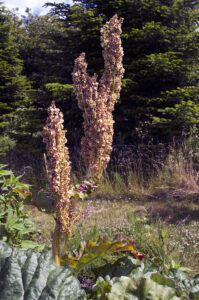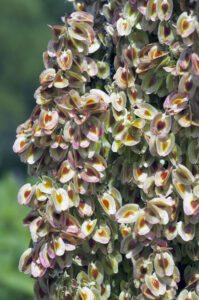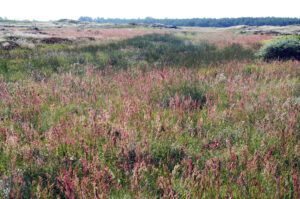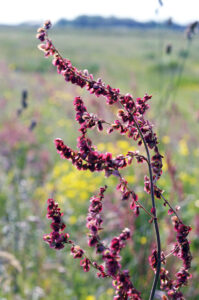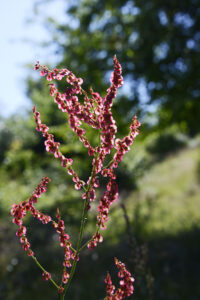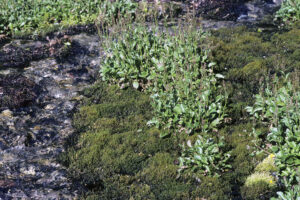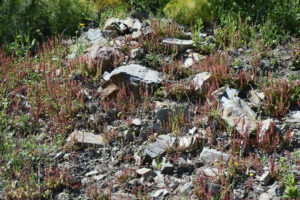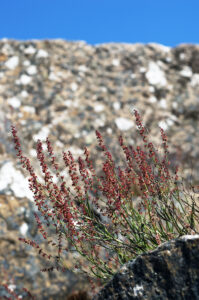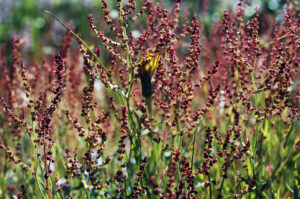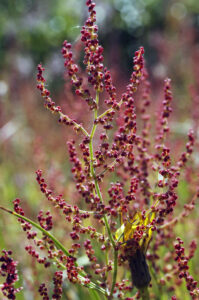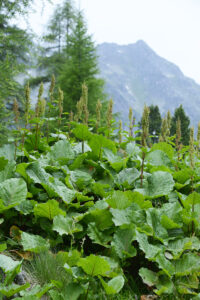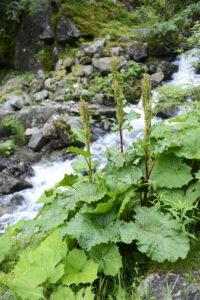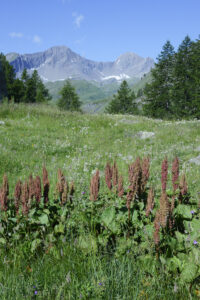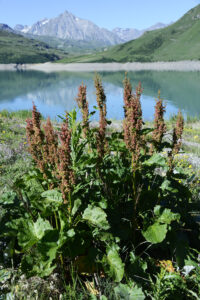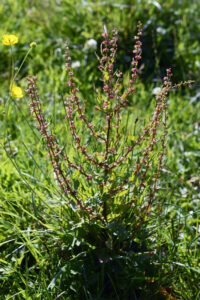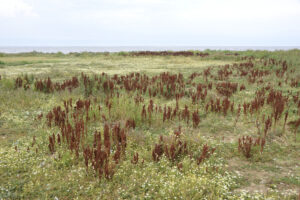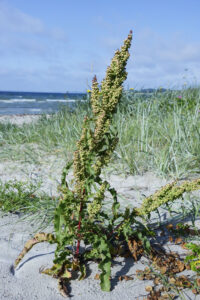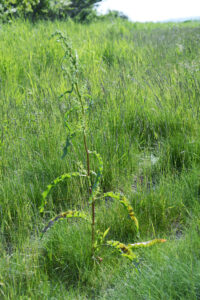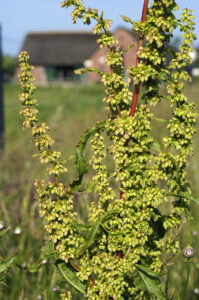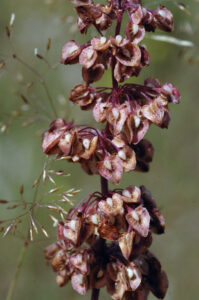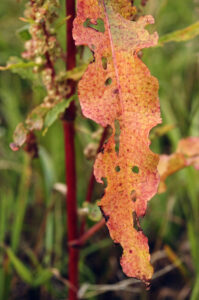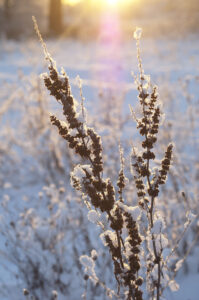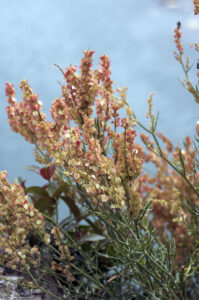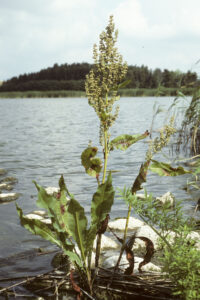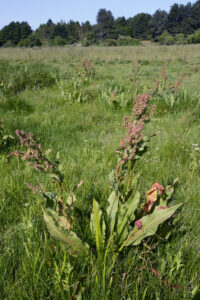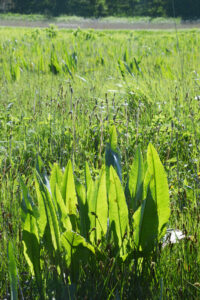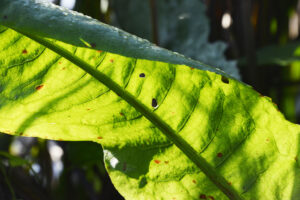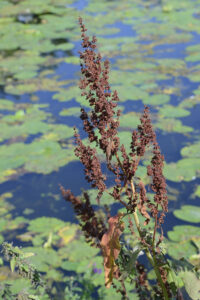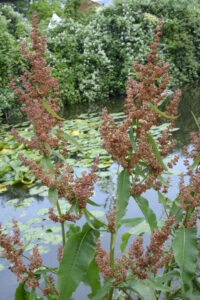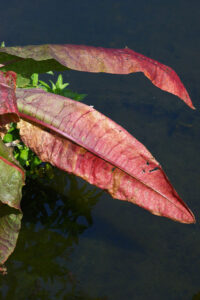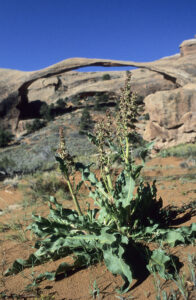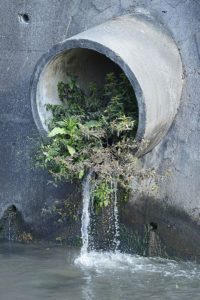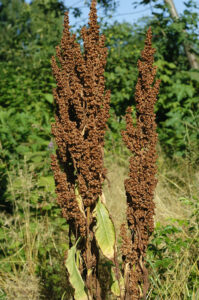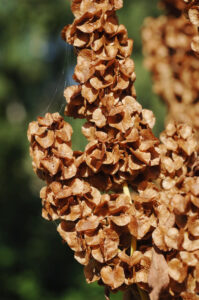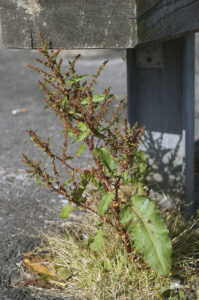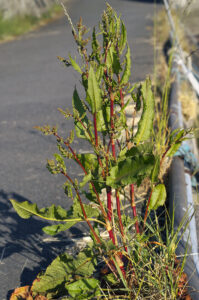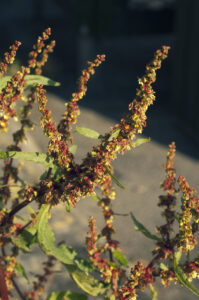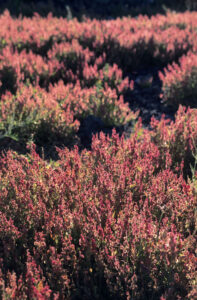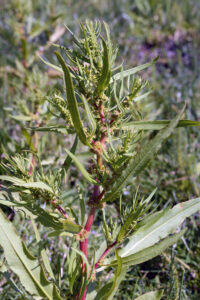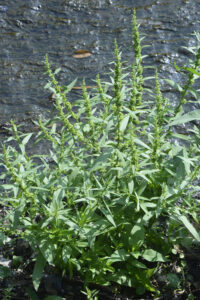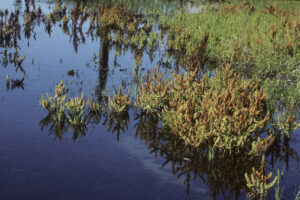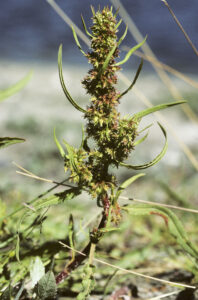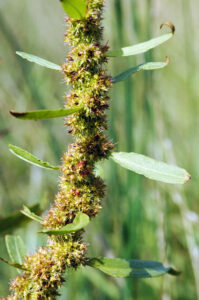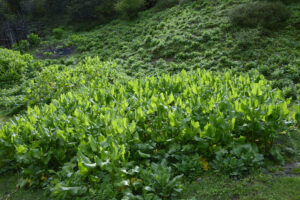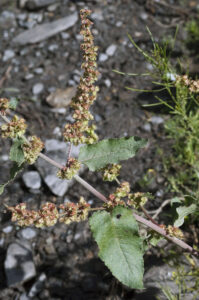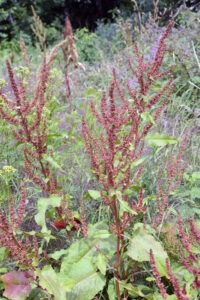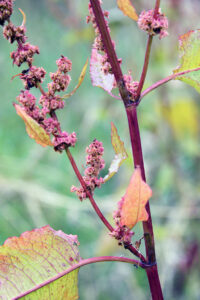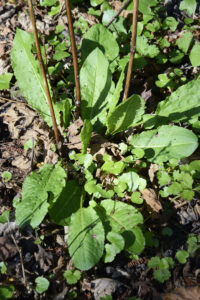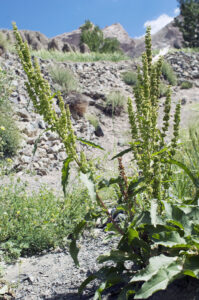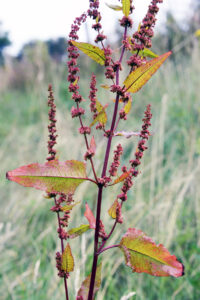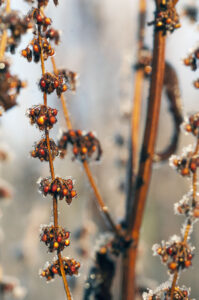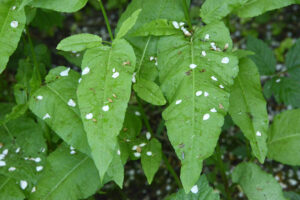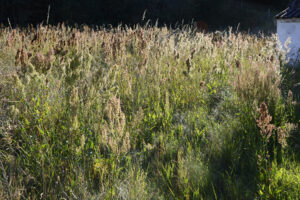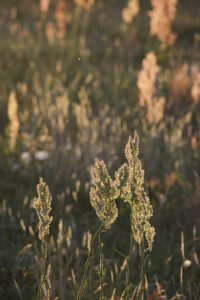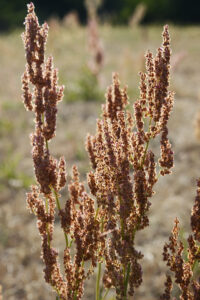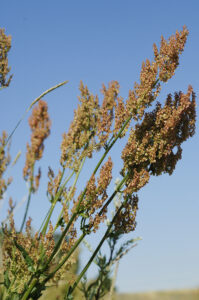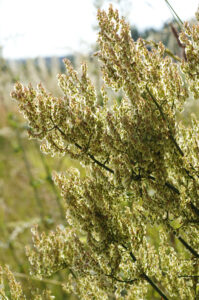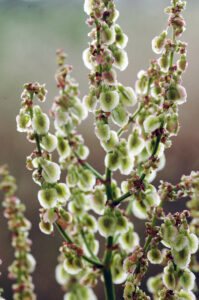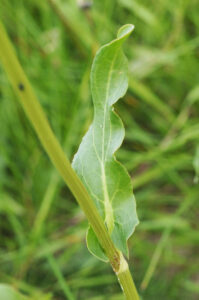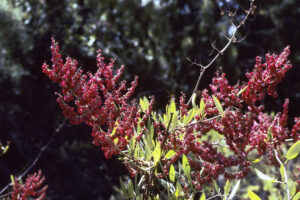Knotweed family
Large growth of the aquatic form of water-pinkweed (Persicaria amphibia), with a mute swan (Cygnus olor), Lake Flyndersø, Jutland, Denmark. (Photo copyright © by Kaj Halberg)
Rocky landscape near the Bara Lacha La Pass (c. 3900 m), Lahaul, Himachal Pradesh, northern India, showing orange-yellow autumn foliage of Bistorta affinis and red foliage of Koenigia tortuosa. (Photo copyright © by Kaj Halberg)
Persicaria perfoliata belongs to those members of the genus, which have fleshy fruits. This picture is from Kathmandu, Nepal. (Photo copyright © by Kaj Halberg)
Colourful autumn leaf of water dock (Rumex hydrolapathum), Lake Gundsømagle, Zealand, Denmark. (Photo copyright © by Kaj Halberg)
Large growth of Koenigia mollis along the Langtang River, between Changdam and Riverside, Langtang Valley, central Nepal. (Photo copyright © by Kaj Halberg)
This large family, in the United States known as the smartweed or buckwheat family, contains roughly 1,200 species in about 48 genera, of which the largest are Eriogonum (c. 250 species), Rumex (c. 200 species), Coccoloba (c. 120 species), Persicaria (c. 100 species), and Calligonum (c. 80 species). Members are found almost worldwide, with the largest diversity in the Northern Temperate Zone.
The family name Polygonaceae is derived from Ancient Greek poly (‘many’) and gony (‘knee’ or ‘joint’), alluding to the swollen and often bent nodes on the stems of most of these plants. In numerous species, the stipules (scale-like or leaf-like appendages at the base of leaf-stalks) are fused into a stem-clasping sheath. The name is based on the genus Polygonum (below), first used in 1789 by French botanist Antoine Laurent de Jussieu (1748-1836) in his book Genera Plantarum.
The popular name knotweed alludes to several creeping species, which often form a dense tangle, a ‘knot’, whereas the name pinkweed alludes to the flower colour of many of these plants. The name smartweed refers to water pepper (Persicaria hydropiper, below), whose leaves have a peppery taste, which may ‘smart’ your mouth. Smart is an old English word, adapted from German Schmerz, which means ‘pain’.
Formerly, many members were lumped in the genus Polygonum. However, morphological and genetic research have had the effect that most of them have been transferred to various other genera, including Bistorta, Fallopia, Koenigia, Persicaria, and Reynoutria, all presented below.
Flowers of these plants only have one type of segments. Whether they are called petals or sepals is an open question. Here I call them petals.
Antigonon
A small genus with 3 species of climbing herbs, native to the Americas.
The generic name is derived from Ancient Greek anti (‘opposite’) and gony (‘knee’, here in the meaning ‘angled’), referring to the zig-zag stems of these plants.
Antigonon leptopus Coral vine
This climbing vine, also known as queen’s wreath, originated on the Pacific and Atlantic coastal plains of Mexico, and is also possibly native to Central America, growing in shrubberies, forest margins, gardens, and disturbed sites, and along roads. It has been widely introduced as an ornamental to most warmer regions of the world and is cultivated in many places for its edible tubers and seeds. It has become naturalized in numerous countries and is often considered an invasive pest.
The stalked leaves are alternate, simple, narrowly heart-shaped, prominently veined, margin wavy. The inflorescences are large racemes, flowers bright pink, fragrant, with 5 petals. They turn brown with age.
The specific name is derived from Ancient Greek leptos (‘thin’) and pous (‘foot’, here in the meaning ‘stem’), thus ‘with slender stems’.
The tombs in this cemetery in Moroni, Grande Comore, Comoro Islands, are almost hidden beneath a dense tangle of coral vine. (Photo copyright © by Kaj Halberg)
Coral vine, escaped in Tunghai University Park, Taichung, Taiwan. In the lower picture, a Japanese white-eye (Zosterops japonicus) is feeding in the flowers. (Photos copyright © by Kaj Halberg)
Bistorta Bistort
A genus of about 40 species, native to subarctic and temperate regions of the Northern Hemisphere, southwards to Mexico, Iran, and Indochina.
The generic name is derived from the Latin bis (‘twice’) and tortus (‘twisted’), referring to the twisted root of the common bistort (B. officinalis, below).
Bistorta affinis
The leaves of this creeping, mat-forming, densely tufted plant are mostly basal, short-stalked, to 8 cm long, blade narrowly elliptic, mid-vein prominent, margin inrolled, entire or finely toothed, stipules papery, brown, to 2.5 cm long. Inflorescences are erect, cylindric spikes, to 7.5 cm long, borne on stalks to 25 cm high, flowers pink or purplish-red, to 6 mm long. The foliage becomes a lovely orange-yellow in autumn (see picture at the top of this page).
It is quite common on open slopes and in rocky areas, from Afghanistan eastwards through southern Tibet and northern Himalaya to Myanmar, growing at elevations between 3,000 and 4,900 m.
In Nepal, the rhizome is used for brewing tea, and also taken for stomach disorders.
The specific name is Latin, meaning ‘kindred’, presumably of another plant.
These pictures were taken at the Rohtang La Pass, Himachal Pradesh, northern India, where Bistorta affinis is very common. (Photos copyright © by Kaj Halberg)
Bistorta affinis, Rakhundi, Great Himalayan National Park, Himachal Pradesh. (Photo copyright © by Kaj Halberg)
Bistorta amplexicaulis
This erect herb grows to 1 m tall, sometimes more. The lower leaves are ovate, long-stalked, blade to 15 cm long and 5 cm wide, tapering to a long point, margin with tiny teeth, whereas the upper leaves are much smaller, clasping the stem. Inflorescences are dense terminal spikes, to 15 cm long and 1.3 cm wide, usually solitary, but sometimes branched, erect in the western Himalaya, but pendulous in variety pendula, found from central Nepal eastwards. Corolla is deep red, sometimes pink or white, to 6 mm long.
It has a wide range, found from Afghanistan eastwards along the Himalaya to central China, growing in shrubberies, forest edges, and open slopes.
In Nepal, the rhizome is utilized for tea, and a paste of the plant is applied to wounds.
The specific name refers to the upper leaves clasping the stem, from the Latin amplexus (‘clasped’) and caulis (‘stem’).
Bistorta amplexicaulis, Rohtang Pass, Himachal Pradesh, northern India. A species of mugwort (Artemisia) is seen in front. (Photo copyright © by Kaj Halberg)
Bistorta amplexicaulis, variety pendula with pendulous inflorescences, Dukpu, below Ganja La, Langtang National Park, central Nepal. (Photo copyright © by Kaj Halberg)
Bistorta amplexicaulis, spikes intermediate between erect and pendulous, Gopte, near Gosainkund, Langtang National Park, central Nepal. (Photo copyright © by Kaj Halberg)
Bistorta macrophylla
Stem erect, unbranched, usually below 10 cm tall, but occasionally to 30 cm. Lower leaves long-stalked, broadly linear to oblong, to 12 cm long and 3 cm broad, but often much narrower, base rounded, margin often inrolled, tip pointed, upper leaves much smaller, almost stalkless. Inflorescences are terminal, rounded or oval, to 2.5 cm long and 1.5 cm broad, corolla red, pink, or white, to 3 mm long.
It is distributed from Uttarakhand, north-western India, eastwards to Bhutan and thence northwards to central China, growing in grasslands and on open slopes at altitudes between 1,700 and 5,000 m, mainly in drier areas.
In Nepal, juice of the root is used for diarrhoea and dysentery.
The specific name is derived from Ancient Greek makros (‘long’) and phyllon (‘leaf’), presumably alluding to the leaves being rather long, compared to the width.
Bistorta macrophylla, Kyangjin Gompa, Upper Langtang Valley, central Nepal. (Photo copyright © by Kaj Halberg)
Bistorta milletii
This plant is found from western Nepal eastwards along the Himalaya to south-western and central China, growing in shrubberies and on open slopes, at elevations between 3,000 and 4,000 m.
Stem to 50 cm tall, lower leaves oblong or lanceolate, parallel-sided, blade to 15 cm long and 4.5 cm wide, abruptly narrowed to a winged leaf-stalk, upper leaves sessile, sometimes clasping the stem. The inflorescence is a dense terminal head, broadly cylindrical or rounded, to 6 cm long, flowers crimson, to 4 mm long.
The specific name honours English plant collector Charles Millett (1792-1873), who corresponded with the famous British botanist William Jackson Hooker (1785-1865). Between 1827 and 1834, Millet was based in Macau, Ceylon (today Sri Lanka), the Malabar region of South India, and Java, working for the East India Company. While in Asia, he collected many plants. He returned to London in 1834.
Bistorta milletii, between Kutumsang and Magingoth, Langtang National Park, Nepal. (Photo copyright © by Kaj Halberg)
Bistorta officinalis Common bistort
This stately plant, by some authorities named Polygonum bistorta or Persicaria bistorta, grows to 80 cm tall, occasionally to 1 m, stem erect, unbranched, smooth. Leaves mostly basal, with a long, winged stalk, ovate-oblong with eared base, usually hairless, to 20 cm long, stem leaves few, alternate, sessile, narrowly triangular, long-pointed, much smaller. Inflorescence is a dense, cylindric, terminal spike, to 7 cm long, with numerous small pink flowers, to 5 mm long.
This species is widespread in temperate areas of central and southern Europe, including the British Isles, eastwards to the Pacific, southwards to Morocco, Iran, and southern China. It is also a common escape in North America. In southern Europe, it is restricted to mountains. It is very common in the Alps, growing in meadows and pastures, at forest edges, and along trails, up to altitudes of about 2,100 m.
Fresh leaves are a valuable fodder, whereas they crumble if they are preserved as hay. The rhizome contains an edible starch, and the leaves were formerly used in folk medicine to treat wounds.
Popular names of this plant include snake-root, alluding to the twisted root, which resembles a moving snake. In Germany, a decoction of the root was used as a remedy for snakebites. The popular name pudding grass refers to an old usage of the leaves in northern England as an ingredient in a bitter Lent pudding, together with other herbs, oatmeal, and eggs.
Common bistort, Great St. Bernhard Pass, on the border between France and Switzerland. (Photo copyright © by Kaj Halberg)
Common bistort, Little St. Bernhard Pass, on the border between Italy and France. (Photo copyright © by Kaj Halberg)
Common bistort, Passo Gardena, Dolomites, Italy. (Photos copyright © by Kaj Halberg)
Bistorta vacciniifolia
A prostrate plant, mat-forming, often covering rocks. Stems woody, much branched, leaves ovate or elliptic, entire, to 2 cm long and 1 cm broad. Sheath to 7.5 mm long, finely toothed, with many brown nerves. Flowering stems axillary or terminal, to 10 cm high, spikes slender, cylindrical, to 8 cm long and 8 mm across, corolla pink or purplish-red, to 4.5 mm long.
It is found from Kashmir eastwards to Bhutan and south-eastern Tibet, growing at elevations between 3,000 and 4,500 m. It is common in wetter areas of Nepal.
In Nepal, juice of the root is utilized for fever.
The specific name is Latin, meaning ‘with leaves like Vaccinium‘ (blueberry).
Bistorta vacciniifolia, Dukpu, near Ganja La, Langtang National Park, central Nepal. (Photo copyright © by Kaj Halberg)
Bistorta vacciniifolia, Tungnath, Uttarakhand, north-western India. The yellow flowers are a species of Saxifraga. (Photo copyright © by Kaj Halberg)
Bistorta vacciniifolia, Gopte, near Gosainkund, Langtang National Park, central Nepal. (Photos copyright © by Kaj Halberg)
Bistorta vivipara Alpine bistort
A very variable plant, stem erect, slender, unbranched, usually below 30 cm tall, but sometimes taller. Basal leaves long-stalked, leathery, usually linear, sometimes ovate-lanceolate or oblong, to 15 cm long and 3 cm broad, base rounded or wedge-shaped, tip pointed or blunt, margin inrolled, upper leaves smaller, stalkless. Sheath to 4 cm long, lower part green, upper brown. The inflorescence is a slender terminal spike, to 10 cm long, corolla pale pink or white, to 3 mm long, lower ones often replaced by brown or purple bulbils, to 4 mm long.
This plant is widely distributed in subarctic and temperate areas of the Northern Hemisphere, southwards to Arizona, Spain, the Caucasus, the Himalaya, and northern Indochina.
In Nepal, the root is used for fever, seeds for cough and infections. The seeds are roasted and pickled.
Formerly, members of the Siberian chukchi people would collect the rootstock, which has a fine almond-like taste. In Nepal, the root is used for fever, seeds for cough and infections. The seeds are roasted and pickled.
The specific name is derived from the Latin vivus (‘alive’) and pario (‘I bear’, i.e. offspring), alluding to the bulbils in the lower part of the spike.
Alpine bistort, growing in a stony area along the Blosseville Coast, eastern Greenland, in humus, which has gathered around a dwarf species of willow (Salix). (Photo copyright © by Kaj Halberg)
Alpine bistort, Honupatta, Ladakh, northern India. (Photo copyright © by Kaj Halberg)
Alpine bistort, Passo Pordoi, Dolomites, Italy. (Photo copyright © by Kaj Halberg)
On this plant, the bulbils have sprouted, Höhlenstein Valley, Tre Cime area, Dolomites, Italy. (Photo copyright © by Kaj Halberg)
Eriogonum American buckwheat
A huge genus, comprising maybe 250 species, all occurring in North America and Mexico.
The generic name is derived from Ancient Greek erion (‘wool’) and gony (‘knee’), alluding to the hairy nodes of the first species to be described, E. tomentosum.
An unidentified species of Eriogonum, Sequoia National Forest, California. Note the tiny, crystal-like grains on the narrow leaves. If you can identify this species, please let me know. (Photo copyright © by Kaj Halberg)
Eriogonum fasciculatum California buckwheat
This shrubby herb, also known as flat-topped buckwheat, is distributed from central California, Nevada, and Utah southwards to southern Baja California and Sinaloa in Mexico, growing in a variety of habitats, including chaparral, grasslands, sagebrush scrub, and pinyon-juniper woodland.
The stems, to about 1.5 m tall, are spreading or erect, stem leaves singly or in bundles at each node, blade linear or oblanceolate, to 1.5 cm long and 5 mm wide, white-woolly or sometimes almost smooth above, greyish or green below, margin often inrolled. The inflorescence is widely branched, rounded or occasionally flat-topped, with numerous compact heads, to 2 cm across, flowers white or pinkish, to 3 mm across.
In former days, this species was widely used medicinally by various tribes for numerous ailments, including colds, headache, diarrhoea, and wounds. It was also eaten raw or used in porridges and baked items, and tea was made from leaves, stems, and root. Today, it is a very important source of honey.
The specific name is a diminutive of the Latin fascis (‘bundle’), referring to the leaf clusters.
Fruiting California buckwheat in evening light, Lake Isabella, Sequoia National Forest, California. (Photos copyright © by Kaj Halberg)
Eriogonum inflatum Desert trumpet
A most striking herb, also known as Indian pipeweed, both popular names given in allusion to its inflated stems. Stem erect, hollow, smooth, bluish-green, to 50 cm tall, leaves basal, long-stalked, to 6 cm long, blade oblong, ovate, or rounded, to 2.5 cm long and wide, greyish or greenish on both surfaces, margin occasionally wavy. The inflorescence is very striking, with widely spreading, pipe-like stalks, each with a spreading cluster of long-stalked, tiny flowers, to 3 mm across, corolla yellow, densely hairy, each petal with a greenish or reddish midrib.
It is found in south-western United States, from California eastwards to Colorado and New Mexico, and in north-western and central Mexico, growing in a variety of habitats, including sandy places, grasslands, saltbush, shrubberies, and piñon-juniper woodlands, from the lowlands to elevations around 2,000 m.
The specific name refers to the inflated stems.
Desert trumpet, Lake Powell, Arizona (top), and Joshua Tree National Park, California. (Photos copyright © by Kaj Halberg)
Withered desert trumpet, Red Rock Canyon State Park, California. (Photo copyright © by Kaj Halberg)
Eriogonum parvifolium Seacliff buckwheat
This species, also called dune buckwheat, is restricted to coastal and near-coastal areas of western California, growing on bluffs, sandy beaches, and dunes, and in grasslands, chaparral-shrubberies, and oak and pine woodlands.
It is a shrub, to 1 m tall, sparsely hairy or smooth, greenish, stem leaves in clusters, or sometimes singly, at the nodes, blade lanceolate or rounded, to 3 cm long and 8 mm wide, smooth and olive-green above, woolly below. The inflorescence is widely branched, with more or less dense heads to about 2.5 cm across, flowers white, pinkish, or greenish-yellow, smooth, to 3 mm across.
The specific name is Latin, meaning ‘with small leaves’.
Seacliff buckwheat, Point Lobos State Park (top), and Andrew Molera State Park, both along coastal California. (Photos copyright © by Kaj Halberg)
Fagopyrum Old World buckwheat
An Asian genus of about 30 species of herbs, most with triangular leaves and nutlets, the vast majority found in western China.
The generic name is derived from the Latin fagus (‘beech’) and Ancient Greek pyros (‘wheat’), alluding to the resemblance of the nutlet to beech nuts. The common name is a corruption of the German name Buchweizen (‘beech-wheat’).
Fagopyrum cymosum
The stem of this species, also known as F. dibotrys, is erect, to 1 m tall, much-branched, green or brownish, hairy. Leaf-stalk to 10 cm, leaves broadly triangular, to 15 cm long and across, base with triangular or arrow-shaped lobes, margin entire, tip pointed. The sheath is brown, to 1.2 cm long. Uppermost leaves smaller, clasping the stem. Inflorescences are terminal or axillary, long-stalked clusters, to 12 cm long, flowers white, to 5 mm across. Nutlets are blackish-brown, triangular, to 8 mm across, sometimes narrowly winged.
It occurs from Pakistan eastwards to central and southern China and northern Indochina, growing in forests, shrubberies, along trails, and in cultivated areas. In the Himalaya, it may be observed up to elevations around 3,400 m.
In Nepal, tender parts are cooked as a vegetable, the leaves cut for fodder, and the seeds used for stomach disorders.
The specific name is Latin, meaning ‘with many shoots’.
Fagopyrum cymosum, Solang Nallah (top), and Naggar, both near Manali, Himachal Pradesh, northern India. (Photos copyright © by Kaj Halberg)
Fagopyrum esculentum Common buckwheat
It is believed that common buckwheat originated in south-western China, but due to its edible seeds it was cultivated at an early stage in numerous countries across the globe.
Stem erect or ascending, green or reddish, branched, sometimes growing to about 1 m tall. The leaves are stalked, blade triangular, heart-shaped, or spear-shaped, prominently veined, to 8 cm long and wide, margin hairy, tip pointed. Inflorescences are terminal or axillary, panicle-like clusters, with white or pale pink flowers, petals elliptic or obovate, to 5 mm long. The nutlets are sharply angled, to about 7 mm long.
The specific name is Latin, meaning ‘edible’, derived from esca (‘food’) and ulentus (‘abounding in’).
Buckwheat (the pink fields) and willow trees (Salix) around the village of Khinga, Jhong River Valley, Mustang, central Nepal. (Photo copyright © by Kaj Halberg)
Seedlings of common buckwheat, 15 days after sowing, Møn, Denmark. (Photo copyright © by Kaj Halberg)
Flowering common buckwheat, Møn. (Photo copyright © by Kaj Halberg)
Harvested buckwheat, drying on house roofs in the village of Lata, Uttarakhand, northern India. (Photo copyright © by Kaj Halberg)
Fallopia
A genus of 12 species, found in temperate areas of the Northern Hemisphere, southwards to southern United States, northern Africa, the Himalaya, and northern Indochina.
The generic name probably honours Italian botanist and anatomist Gabriele Falloppio (1523-1562), who was superintendent of the botanical garden at Padua.
Fallopia convolvulus Black bindweed
This vine grows to more than 2 m long, twining clockwise around other plants, fences, etc. The leaves are stalked, more or less heart-shaped, to 6 cm long and 3 cm broad, tip long-pointed. The small flowers are greenish-white or greenish-pink, in short, dense racemes.
Black bindweed mostly grows on disturbed or cultivated land, and it may sometimes be a noxious weed. It is widely distributed in temperate areas of Eurasia, southwards to northern Africa, the Himalaya, and northern Indochina. In the northern parts of its range it is found down to sea level, whereas in the southern parts it is restricted to mountains. In China, it has been observed up to an elevation of 3,600 m. It has become naturalized in many other areas of the world.
The seeds are edible. Remains have been found in Bronze Age middens, indicating that it was a food crop in those days.
The specific name refers to its climbing habit and the shape of the leaves, by which it resembles bindweeds, genus Convolvulus, described on the page Plants: Morning glories and bindweeds.
Black bindweed, growing on a noble fir (Abies procera), Zealand, Denmark. (Photo copyright © by Kaj Halberg)
Here, black bindweed is climbing up a fence, Jutland, Denmark. (Photos copyright © by Kaj Halberg)
Black bindweed, climbing on a grass stem, Jutland, Denmark. (Photo copyright © by Kaj Halberg)
Koenigia
This genus, comprising about 35 species, is widely distributed in the Northern Hemisphere, with a core area in Central Asia. Many members were formerly placed in the genus Aconogonum.
In Nepal, the slightly acid stems of some members are chewed when young.
The generic name commemorates Baltic-German botanist and physician Johann Gerhard König (1728-1785), a pupil of Swedish naturalist Carl Linnaeus (1707-78) in 1757. While living in Denmark 1759-67, he was sent to Iceland to examine the flora. Later, he served in the Danish Tranquebar Mission in South India, before serving under the Nawab of Arcot, and later the English East India Company. He collected many plants from the region.
Koenigia alpina Alpine knotgrass
This species, formerly called Aconogonum alpinum or Polygonum angustifolium, grows to 2 m tall, stem erect, pink or white, grooved, sparsely hairy or hairless, branched above. Leaves short-stalked, lanceolate, to 13 cm long and 3.5 cm broad, finely hairy beneath, base wedge-shaped, margin entire, tip pointed. Sheath brown, to 2.5 cm long. Inflorescences are terminal, much-branched, pyramid-shaped clusters, to 30 cm long, flowers numerous, creamy white, yellowish, or pale pink, petals 5, elliptic, to 3 mm long.
It is widely distributed, from southern and eastern Europe eastwards across the Middle East and Central Asia to the Pacific Ocean, southwards to Iran, the Himalaya, and northern Indochina, growing in shrubberies, on open slopes, and along streams.
The stem is edible when cooked.
Alpine knotgrass, growing at a stream near Kielang, Lahaul, Himachal Pradesh, northern India. (Photos copyright © by Kaj Halberg)
Alpine knotgrass, Koksar, Lahaul, Himachal Pradesh. (Photo copyright © by Kaj Halberg)
Koenigia campanulata
This plant, previously known as Aconogonum campanulatum, differs from other members of the genus by its bell-shaped flowers, and the leaf nerves being deeply impressed on the upper surface. Stem erect, to 1.2 m tall, leaves leathery, elliptic or lanceolate, long-pointed, to 16 cm long and 5 cm wide, pinkish-brownish hairy beneath, nerves on upper surface deeply impressed. Sheath short, usually below 1 cm long, bristly-hairy. Inflorescences are axillary or terminal, rather small and compact clusters, erect or nodding, flowers bell-shaped, pinkish or white, to 5 mm long.
It is found from Uttarakhand, north-western India, eastwards to northern Myanmar and south-western China, growing in open forests and shrubberies, and along streams.
In Nepal, tender parts are cooked as a vegetable.
The specific name was given in allusion to the bell-shaped flowers, from the Latin campanula (’little bell’).
Koenigia campanulata, Ghangyul (2500 m), Helambu, central Nepal. (Photo copyright © by Kaj Halberg)
Koenigia islandica
A dwarf herb, tufted, to 10 cm tall, stems reddish, slender, smooth, with spreading branches, rooting at the nodes. Leaves alternate, short-stalked, blade broadly elliptic, or rounded, to 5 mm long and across, smooth, margin entire, tip blunt. Sheath brown, to 2 mm long, membranous. Inflorescences axillary, in dense clusters of up to 15 flowers, petals white, cream-coloured, or greenish, to 1 mm long.
This plant is widespread in subarctic regions, extending into temperate areas southwards to Arizona, the British Isles, Pakistan, Ladakh, and western China. It grows in humid grasslands and along streams.
The specific name refers to Iceland, where König (see generic name above) first collected this species in 1765.
Koenigia islandica, Ulley, Ladakh, northern India. (Photo copyright © by Kaj Halberg)
Koenigia mollis
This plant, previously called Aconogonum molle, is gregarious, often forming dense growths in open forests and shrubberies, and along streams. Stem erect, many-branched, rounded, to 2.5 m tall, base woody, stem and branches downy-hairy. Leaves short-stalked, elliptic-lanceolate, to 20 cm long and 7 cm broad, silky-hairy beneath, downy above, nerves not impressed. Sheaths dark-brown, 3-7 cm long. Inflorescences terminal, much branched, hairy, to 40 cm long, flowers to 5 mm across, cream-coloured or white. Fruit black, rounded, to 3 mm across.
It is distributed from Uttarakhand, north-western India, eastwards to southern China, and thence southwards through Indochina to Indonesia.
In Nepal, tender parts are cooked as a vegetable, and also pickled.
The specific name is Latin, meaning ‘soft’ or ‘delicate’, alluding to the downy-hairy stems and leaves.
Koenigia mollis, Shermatang (2500 m), Helambu, central Nepal. (Photo copyright © by Kaj Halberg)
Koenigia mollis, all photographed in the Lower Langtang Valley, central Nepal. (Photos copyright © by Kaj Halberg)
Koenigia polystachya
Much like K. campanulata (above), but stem and branches usually very dark, leaf nerves on upper side less deeply impressed, and flowers open, not bell-shaped. Stem to 1.8 m tall, much branched, angled, often hairy above. Leaves broadly lanceolate, to 17 cm long and 7 cm wide, downy-hairy below, margin wavy, tip pointed. Sheath dark brown, downy-hairy, to 4 cm long. Inflorescences are terminal panicles, much-branched, spreading, to 45 cm long, with pink or whitish flowers, to 6 mm across.
It grows in forests and open areas, and at streamsides, from Afghanistan eastwards to northern Myanmar and south-western China, found at elevations between 2,000 and 4,500 m.
In Nepal, tender parts are cooked as a vegetable.
This species was previously known as Persicaria polystachya, Persicaria wallichii, or Polygonum wallichii.
The specific name is derived from Ancient Greek polys (‘many’) and stachys, which originally meant ‘an ear of grain’, but in a botanical context used for ‘spike’ (an inflorescence with many stalkless seeds along a central axis). Thus, polystachya means ‘with many spikes’, alluding to the abundant number of (false) spikes on this plant.
Koenigia polystachya, Kielang, Lahaul, Himachal Pradesh, northern India. (Photo copyright © by Kaj Halberg)
Koenigia polystachya, Gopte, near Gosainkund, Langtang National Park, central Nepal. (Photos copyright © by Kaj Halberg)
Koenigia polystachya, Rohtang Pass, Himachal Pradesh. (Photos copyright © by Kaj Halberg)
Koenigia tortuosa
Formerly called Aconogonum tortuosum, this plant is erect, stem much branched, to 50 cm tall, reddish-brown, shining, hairless. Leaves stalkless, ovate or elliptic, to 4 cm long and 3 cm broad, leathery, pale green, hairless, base rounded, margin entire, wavy, hairy, tip pointed. Sheath brown, to 2 cm long, densely downy. Inflorescences are terminal, cylindrical, dense clusters, to 5 cm long, flowers white or cream-coloured, bell-shaped, petals to 3.5 mm long. The foliage becomes a lovely crimson in autumn, often dyeing entire mountain slopes.
This species is distributed in dry and stony regions, from Afghanistan eastwards across northern Pakistan, Ladakh, and Tibet to northern Nepal and northern Arunachal Pradesh, found at elevations between 3,300 and 5,600 m.
It is used medicinally for dysentery.
The specific name is derived from the Latin tortus (‘twisted’) and osus (‘plenty’), referring to the twisted leaves.
Koenigia tortuosa, Polo Kongga La (4600 m), Ladakh, northern India. (Photo copyright © by Kaj Halberg)
Koenigia tortuosa, Ulley, Ladakh. (Photo copyright © by Kaj Halberg)
Rocky landscape around the Bara Lacha La Pass (3900 m), Lahaul, Himachal Pradesh, northern India, with crimson autumn foliage of Koenigia tortuosa and golden-yellow of Bistorta affinis (presented above). (Photo copyright © by Kaj Halberg)
Oxyria
A small genus with only 3 species, O. caucasia in the Caucasus, northern Iraq, and northern Iran, O. sinensis in western China and Tibet, and O. digyna (below).
The generic name is derived from Ancient Greek oxys (‘sour’) and aria (‘possessing’), alluding to the acidic leaves of these plants.
Oxyria digyna Mountain sorrel
Stems solitary or several, grooved, to 50 cm, sometimes more. Leaves mostly basal, stalk to 13 cm long, grooved, blade pale green, rather fleshy, rounded, heart-shaped, or kidney-shaped, hairless, to 5 cm across, margin entire. Stem and leaves often turn reddish. Sheath to 1.5 cm long, brownish, pointed. The branched inflorescence has long, slender spikes, each with many whorls of greenish or pinkish-white flowers, to 3 mm across. Fruit ovoid, to 3.5 mm across, wings to 3 mm broad, pinkish, later turning red.
The native range of this species is subarctic and temperate regions of the Northern Hemisphere, southwards to Arizona, Iran, the Himalaya, and western China, growing on open slopes and grazing grounds, and along streams and trails. In Central Asia, it may be encountered up to altitudes around 5,200 m.
The leaves are edible, raw or cooked. In Nepal, root, stem, and leaves are used for treatment of dysentery.
The specific name is derived from Ancient Greek dis (‘two’) and gyne (‘woman’), referring to the flower having 2 stigmas.
Mountain sorrel, growing close to the glacier Svartisen, Norway. The plant with yellow flowers is yellow mountain saxifrage (Saxifraga aizoides). (Photo copyright © by Kaj Halberg)
In this picture, mountain sorrel has sprouted in a neglected stone fence, Peokar, near Kielang, Lahaul, Himachal Pradesh, northern India. (Photo copyright © by Kaj Halberg)
Mountain sorrel, Mangyu, Ladakh, northern India. (Photo copyright © by Kaj Halberg)
Mountain sorrel, Kielang, Himachal Pradesh. (Photo copyright © by Kaj Halberg)
Autumn stems of Oxyria digyna with seeds, near Ganja La (4700 m), Langtang National Park, central Nepal. (Photo copyright © by Kaj Halberg)
Persicaria
A large genus with about 130 species, found almost worldwide. They were previously included in the genus Polygonum.
The generic name is derived from the Latin persica (‘peach-like’), alluding to the leaves of some members resembling peach leaves.
Persicaria amphibia Water-pinkweed
This herb is very variable and comes in two very different forms, one aquatic, growing in stagnant water, with floating leaves and a stem that can be 2-3 m long, and a terrestrial form, to 60 cm tall, which grows in meadows and swampy areas. The leaves are long-stalked, lanceolate, oblong, or elliptic, to 14 cm long and 4 cm wide, smooth, margin entire, hairless in aquatic plants, hairy in terrestrial plants. Sheath to 2 cm long, membranous, with short hairs above. Inflorescences are terminal or axillary spikes, to 4 cm long, pinkish or white.
It is native to subarctic and temperate areas of the Northern Henisphere, southwards to Central America, Arabia, and China, and also occurs in Ethiopia, Kenya, and South Africa.
The specific name is derived from the Greek amfi (‘both sides’) and bios (‘life’), thus ‘living on both sides’, referring to the fact that the plant is found in water as well as on dry land.
Large growth of the aquatic form of water-pinkweed, Lake Hampen, Jutland, Denmark. (Photo copyright © by Kaj Halberg)
Aquatic form of water-pinkweed, Nature Reserve Vorsø, Jutland. (Photo copyright © by Kaj Halberg)
Aquatic form of water-pinkweed and common duckweed (Lemna minor), Jutland. (Photo copyright © by Kaj Halberg)
Aquatic form of water-pinkweed, Romsø, Funen, Denmark. (Photo copyright © by Kaj Halberg)
Large growth of the terrestrial form of water-pinkweed, Nature Reserve Vorsø, Jutland. (Photo copyright © by Kaj Halberg)
Terrestrial form of water-pinkweed, Funen (top), and Mols, Jutland. (Photos copyright © by Kaj Halberg)
Persicaria capitata
A prostrate herb, stems erect or ascending, branched, to 25 cm long, sparsely hairy or hairless, rooting from the nodes. The short-stalked leaves are ovate or elliptic, to 3.8 cm long and 2.5 cm broad, both surfaces glandular-hairy, often with a blackish V-shaped spot on the upper surface, base wedge-shaped, margin bristly-hairy, tip pointed. Sheath to 1.2 cm long, brown, glandular-hairy. Inflorescences are terminal globular heads, pink or whitish, to 1.3 cm across, flowers to 2 mm long.
It is distributed from Pakistan eastwards to Taiwan, southwards to Sri Lanka and northern Malaysia, growing in a variety of habitats, including rocks, stone fences, and open slopes, and along trails, found at elevations between 600 and 3,500 m.
In Nepal, a paste of the plant is applied to boils and wounds, and its juice is taken for stomach problems. The plant is collected for fodder.
The specific name is Latin, meaning ‘forming a head’, alluding to the globular inflorescence.
Persicaria capitata, Sundarijal, Kathmandu Valley, Nepal. (Photo copyright © by Kaj Halberg)
Persicaria capitata, Timbu, Helambu, central Nepal. (Photo copyright © by Kaj Halberg)
Persicaria capitata, growing in a crack in a stone fence, Helambu. (Photo copyright © by Kaj Halberg)
Persicaria chinensis Chinese knotweed
An extremely variable plant, stem erect, many-branched, to 1 m tall, woody at the base. Leaves short-stalked, ovate, elliptic, or lanceolate, to 16 cm long and 8 cm wide, usually smooth, base truncate or broadly cordate, margin entire, tip pointed. Sheath membranous, smooth, to 2.5 cm long, with many veins. Inflorescences are terminal or axillary heads, to 5 mm across, usually several heads together, forming what looks like a loose panicle-like, stalk densely glandular-hairy, flowers white or pinkish. The fruit is black, looking somewhat like a berry, to 4 mm across.
This species grows in forests, shrubberies, and on open slopes, from sea level to an altitude of about 3,000 m. It is distributed from Pakistan eastwards to Korea and Japan, southwards to Sri Lanka, Indonesia, and the Philippines.
Chinese knotweed, Basianshan National Forest, Taiwan. (Photo copyright © by Kaj Halberg)
Chinese knotweed, Dasyueshan National Forest, central Taiwan. (Photos copyright © by Kaj Halberg)
Fruiting Chinese knotweed, Hohuan Shan (top), and Wuling National Forest, both in Taiwan. (Photos copyright © by Kaj Halberg)
Leaves of Chinese knotweed, Mingtsih, central Taiwan. (Photo copyright © by Kaj Halberg)
Persicaria glabra
This herb is smooth in all parts, which is reflected in the specific name. Stem erect, to 1 m tall, rarely branched. Leaves lanceolate, to 18 cm long and 3 cm wide, margin entire, tip long-pointed. Sheath to 3 cm long, membranous, with numerous veins. Inflorescences are terminal, from 4 to 12 cm long, usually with several spikes together, forming what looks like an open panicle, flowers white or pinkish.
It is partial to wet areas, growing along streams and in marshes. It is very widely distributed in warmer regions, in south-eastern United States, Mexico, Central America, and in large parts of South America, in Sudan and Ethiopia, and the Arabian Peninsula, and from Pakistan eastwards to Taiwan, southwards to Sri Lanka, Indochina, and the Philippines.
Persicaria glabra, growing in a drainage canal, Taichung, Taiwan. (Photos copyright © by Kaj Halberg)
Persicaria hydropiper Water pepper, smartweed
Stem erect, to 70 cm tall, much branched, smooth, leaves short-stalked, lanceolate or elliptic-lanceolate, to 8 cm long and 2.5 cm wide, smooth, margin hairy, tip pointed. Sheath tubular, to 1.5 cm long, membranous, sparsely hairy, tip with short hairs. Inflorescences are terminal or axillary, slender, lax spikes, pendulous, to 8 cm long, corolla greenish, white, or pink, to 3.5 mm long.
Very widely distributed, found from the entire Europe eastwards across Central Asia to the Pacific Ocean, southwards to North Africa, Iran, Sri Lanka, Indonesia, and Australia. It grows in wet meadows, and along rivers and ponds.
In Nepal, the plant is boiled, and the filtered water is taken to expel intestinal parasites. The plant is also strewn in water to stupefy fish.
The specific name is derived from Ancient Greek hydor (‘water’) and peperi (‘pepper’), ultimately from Sanskrit pippali. It refers to the leaves, which have a strong peppery taste, also reflected in the name smartweed, derived from old English smeortan (‘to cause pain’), originally from German Schmerz (‘pain’).
In his delightful book All about Weeds, American botanist Edwin Spencer (1881-1964) writes: “There are a great many species (…) which look somewhat like this weed, but most of them lack the ‘smart’ taste entirely, and none of them possess the fire of hydropiper.”
Water pepper, southern Zealand, Denmark. (Photos copyright © by Kaj Halberg)
Water pepper, Parvati River Valley, near Manikaran, Himachal Pradesh, northern India. (Photo copyright © by Kaj Halberg)
Persicaria lapathifolia Pale persicaria, pale smartweed
This plant is very widely distributed, native to most subarctic, temperate, and subtropical regions of the world, except South America and the southern half of Africa. However, it has become naturalized many places in these two continents. It grows in open areas, preferring rather damp soil.
It is an annual, stem to about 90 cm tall, green or reddish, smooth or downy-haired, swollen at the nodes. Leaves almost sessile, lanceolate or narrowly elliptic, to 15 cm long and 3 cm wide, the upperside often with a dark blotch in the centre, margin hairy. The sheath is brownish or transparent, to 3 cm long, sometimes fringed with a few hairs above. The inflorescences are terminal or axillary, dense spikes, erect or nodding, to 8 cm long, often with several spikes close together, forming what looks like a loose panicle. Corolla pink or white, petals to 3 mm long.
The young leaves are edible raw, and in some areas young plants are cooked as a vegetable. Medicinally, it is used as an astringent, and for inflammation, stomach problems, and fever. The plant produces a soft, white, soap-like mass, used for bathing and washing clothes.
The specific name is derived from the Latin lapathi, an old name for docks and sorrels (Rumex, see below), and folius (‘leaf’). The name smartweed alludes to its similarity to the ‘true’ smartweed, P. hydropiper (above).
This species is very similar to the following one, and telling them apart is far from easy. A detailed identification key is found in this article: M. Wilcox, 2021. Recording Persicaria maculosa and P. lapathifolia (Polygonaceae). British & Irish Botany 3(3): 349-361, web version Wilcox+Final.pdf.
Large growth of pale persicaria, Nature Reserve Klægbanken, Ringkøbing Fjord, Denmark. Reed canary-grass (Phalaris arundinacea), reed (Phragmites australis), and creeping thistle (Cirsium arvense) are also present. (Photo copyright © by Kaj Halberg)
This plant has greenish-white inflorescences – a character that separates pale persicaria from spotted persicaria. – Djursland, Denmark. (Photo copyright © by Kaj Halberg)
The plants in these pictures are tentatively identified as pale persicaria, Funen (top), and Djursland, Denmark. (Photos copyright © by Kaj Halberg)
Persicaria maculosa Spotted persicaria
As mentioned above, this plant is very similar to the previous species, and they grow in the same habitats. The inflorescences are usually a darker red, and the sheath is usually fringed with many long hairs above, but these characters are not enough to identify it with certainty.
It is native to temperate and subtropical regions of Eurasia and northern Africa, but has become naturalized in numerous countries across the globe.
The specific name is Latin, meaning ‘spotted’, referring to numerous glands on the underside of the leaves – which, however, are often insignificant and hard to see.
These plants are probably spotted persicaria, as they possess both characters mentioned above. – Funen (top), and Djursland, both in Denmark. (Photos copyright © by Kaj Halberg)
Persicaria orientalis
A robust plant, stem erect, to 2 m tall, many-branched above, densely hairy. Leaves are short- or long-stalked, ovate, elliptic, or broadly lanceolate, to 20 cm long and 12 cm wide, both surfaces and margin downy-haired, base rounded, tip pointed. Sheath to 2 cm long, membranous, hairy, usually with green, leaflike wing, clasping the stem. Inflorescences are terminal or axillary spikes, slightly pendulous, to 7 cm long, usually several spikes close together, forming what looks like a loose panicle. Corolla pink or white, petals to 4 mm long.
It grows in many habitats, including streamsides, roadsides, and wastelands. As its specific name implies, it is an eastern species, occurring naturally from the Indian Subcontinent eastwards to Taiwan, and thence northwards to Ussuriland (south-eastern Siberia), southwards to the Philippines, Indonesia, New Guinea, and eastern Australia. However, it is widely cultivated and has become naturalized in numerous countries around the world.
Medicinally, it has a wide range of uses, including treating rheumatism, promoting digestion, aiding diuresis, and activating blood circulation. It is also used against inflammation and diarrhoea.
Persicaria orientalis is abundant along the Suei Wei River, Taichung, Taiwan, where these pictures were taken. (Photos copyright © by Kaj Halberg)
Persicaria perfoliata
Stem reddish, trailing or scrambling, to 2 m long, branched, angulate, armed with back-pointing prickles. Leaves have a prickly stalk, to 8 cm long, blade triangular, to 6 cm long and 8 cm wide, prickly along veins below, smooth above, base shallowly heart-shaped, tip pointed. Sheath tubular, with a leaf-like, rounded ear at the tip, to 3 cm across, clasping the stem. Inflorescences are terminal or axillary spikes, to 3 cm long, corolla white or pinkish, to 3 mm long. The spectacular fruit is metallic blue, shining, fleshy, berry-like.
This plant grows in shrubberies and open areas, and along trails and roads. It is very widely distributed, from Turkey and the Caucasus eastwards to Ussuriland (south-eastern Siberia), China, Korea, Japan, Taiwan, the Indian Subcontinent, Indochina, Indonesia, New Guinea, and the Philippines. It has also been accidentally introduced elsewhere and has become naturalized in many places. In North America and Europe, it is regarded as an invasive species.
Ripe fruits are edible. In Nepal, tender parts are cooked as a vegetable, and juice of the leaves is taken for backache. It is also used for various purposes in traditional Chinese medicine. The foliage provides good fodder, and stems can be used to make ropes.
The specific name is a botanical term, used when the stem seemingly passes through the leaf blade, from the Latin per (‘through’) and foliatus (‘leafy’), in this case alluding to the leaf-like ears at the nodes. Common names include mile-a-minute vine, which alludes to the rapid growth of the plant, and devil’s tail and climbing tearthumb, which both refer to its vicious prickles.
Persicaria perfoliata with fruits, Jagat, Lower Marsyangdi Valley, Annapurna (top), and Kathmandu, both Nepal. (Photos copyright © by Kaj Halberg)
Persicaria pubescens
Stem erect, often reddish, to 90 cm tall, branched above, leaves short-stalked, blade lanceolate, to 10 cm long and 2.5 cm wide, margin hairy, tip pointed. Sheath tubular, to 1.5 cm long, membranous, hairy. Inflorescences are terminal or axillary spikes, slender, lax, pendulous, to 15 cm long, interrupted below. Corolla red, pink, or green, to 4 mm long.
It is distributed from the Indian Subcontinent eastwards to China, Korea, Japan, and Taiwan, and thence southwards to Indonesia, growing in shrubberies and open areas, and along fields and streams.
In Nepal, it is strewn in streams to stupefy fish.
The specific name is Latin, meaning ‘downy-hairy’ – not a descriptive name!
This species resembles Persicaria hydropiper (above), but may be identified by the stem and the inflorescence, which are both often red.
Persicaria pubescens, Chisapani, Helambu, central Nepal. (Photo copyright © by Kaj Halberg)
Persicaria runcinata
Stems several, ascending, sometimes creeping, to 60 cm long, smooth or sparsely hairy, but nodes often bristly-hairy. Leaves short-stalked, stalk narrowly winged, base eared, blade pinnately divided, to 8 cm long and 4 cm wide, terminal lobe triangular, pointed, lateral lobes 1-3 pairs, smaller than and pointing backwards from the terminal one, margin with short hairs. Sheath tubular, densely hairy, to 1 cm long. Inflorescence a dense terminal head, to 1.5 cm in diameter, stalk glandular-hairy, petals pinkish or white, to 3.5 mm long.
It is found in grasslands, shrubberies, and open humid slopes, from Uttarakhand, north-western India, eastwards to eastern China and Taiwan, and thence southwards to Java and the Philippines.
In Nepal, young parts are cooked as a vegetable.
The botanical meaning of the specific name is ‘pointing backwards from the tip’, alluding to the lobes on the leaves.
Trailing stems of Persicaria runcinata, Kutumsang, Helambu, central Nepal. Note the pinnately divided leaves. (Photo copyright © by Kaj Halberg)
Persicaria senticosa
Stem trailing or climbing, to 1 m tall, many-branched, angulate, with recurved prickles along the angles. Leaves have a prickly stalk, to 7 cm long, blade triangular, to 8 cm long and 7 cm wide, prickly along veins below, smooth above, base arrow- or heart-shaped, with two triangular lobes, tip pointed, both surfaces hairy, margin with recurved prickles. Sheath to 1 cm long, membranous, at the tip with a green, leaf-like, stem-clasping ear, margin strongly hairy. Inflorescences are terminal or axillary heads with 2-3 flowers, flower stalks prickly and glandular-hairy, to 5 cm long. Flowers white or pink, petals to 4 mm long.
This plant grows in forests and shrubberies, and on open slopes, found up to elevations around 1,500 m. It is distributed from Ussuriland (south-eastern Siberia), southwards through eastern China, Korea, Japan, and Taiwan to northern Vietnam.
Young parts may be cooked as a vegetable.
The specific name is derived from the Latin sentis (‘thorn’) and osus (‘full of’) – a descriptive name!
Young shoot of Persicaria senticosa, Lugu, Taiwan. (Photo copyright © by Kaj Halberg)
Polygonum Knotweed, knotgrass
According to the latest revision, this genus contains about 160 species, distributed across the globe, except in Antarctica and certain rainforest areas. Many of them are very much alike and often difficult to tell from each other.
The generic name is explained at the top of this page. The common names allude to the fact that these plants often form a dense tangle, a ‘knot’.
Polygonum arenastrum
This species is distributed in temperate regions of Eurasia and North Africa. It was previously regarded as a subspecies, calcatum, of prostrate knotweed (below). These two species are extremely similar. The plant in the picture below was identified by the late Bernt Løjtnant (1946-2020), a renowned Danish botanist.
The specific name is derived from the Latin arena (‘sand’), thus ‘of the sand’, i.e. ‘growing in sand’.
Polygonum arenastrum, observed on the islet Svanegrund, eastern Jutland, Denmark. (Photo copyright © by Kaj Halberg)
Polygonum aviculare Prostrate knotweed, common knotgrass
This prostrate herb is very common, growing on sandy beaches, in fields and wasteland, and in towns. It is tolerant of trampled soil and may even grow in the middle of paths, and it often invades neglected lawns. It is widespread in temperate regions of the Northern Hemisphere, probably native to Eurasia as well as North America, and it has also become naturalized in temperate areas of the Southern Hemisphere.
Prostrate knotweed is very variable, and in its widest sense it contains a number of species or subspecies, including arenastrum (above). It is branched from the base, stems mostly creeping, but occasionally ascending, growing to 70 cm long/tall, sometimes more. Leaves are numerous, short-stalked, linear, lanceolate, or elliptic, on the main stem to 4 cm long and 1.2 cm wide, smaller on the branches, margin entire, tip pointed or rounded. The small flowers, to 4 mm across, are solitary or in small clusters at the nodes, corolla white or pinkish, often with a greenish base.
This species is eagerly eaten by cows and chickens, and the seeds are much relished by small birds. This was observed by Swedish naturalist Carl Linnaeus (1707-78), when he named the plant aviculare, derived from the Latin avicula (‘small bird’).
In folk medicine, the juice has been used to stop nose-bleed and other types of bleeding. Tea made from the plant was used for diarrhoea, cough, bronchitis, and bleeding haemorrhoids.
In his play A Midsummer Night’s Dream, William Shakespeare (1564-1616) calls this plant “the hindering knotgrass”. In those days, it was believed that its juice would interfere with the growth of young children and domestic animals.
This prostrate knotweed has sprouted among bricks, laid out as tiles, Jutland, Denmark. (Photos copyright © by Kaj Halberg)
Prostrate knotweed, an ascending form, Zealand, Denmark. (Photo copyright © by Kaj Halberg)
Polygonum plebeium
A very variable, mat-forming plant, stems creeping or ascending, to 40 cm long, densely branched from the base, internodes usually shorter than the leaves, which are very short-stalked, linear, oblanceolate, or elliptic, to 1.5 cm long and 4 mm broad, midvein conspicuous, base wedge-shaped, margin entire, tip blunt or pointed. Sheath membranous, to 3 mm long, tip lacerated. Flowers 3-6 in axillary clusters, stalkless, partly concealed by papery, fringed sheaths, petals white, pinkish, or greenish, narrowly elliptic, to 3 mm long, with prominent veins beneath.
This species is found in South and East Asia, Indochina, the Philippines, Australia, most of Africa, and Madagascar, growing in dry rice fields and humid grasslands, and along trails.
In Nepal, the plant is boiled, and the juice taken for dysentery, juice of the root for stomach trouble. Tender parts are cooked as a vegetable.
Polygonum plebeium, Lake Deepak Tal (c. 3800 m), Lahaul, Himachal Pradesh, northern India. (Photo copyright © by Kaj Halberg)
Reynoutria
A small genus of 4 species, native to eastern Asia, from Ussuriland and Sakhalin (south-eastern Siberia), southwards to China and Taiwan.
The generic name commemorates Charles de Saint Omer (1533-1569), Lord of Reynoutre. Flemish botanist Matthias van Lobel (1538-1616) testifies “dat dezelve aan de Kruidkunde zeer veel dienst gedaan heest.” (‘that the same to Herbology has done much service’).
Reynoutria japonica Japanese knotweed
This species, previously known as Fallopia japonica or Polygonum cuspidatum, is native to the Far East, found in Ussuriland (south-eastern Siberia), Korea, Japan, China, and Taiwan.
This large plant may grow to 4 m tall, but under harsh conditions it is often much smaller (see upper photo below). It has hollow stems with distinct nodes, making it resemble bamboo. The leaves are broadly ovate, to 14 cm long and 9 cm wide, base mostly truncate, but varies a great deal, margin entire. The small flowers, white or cream-coloured, are arranged in racemes, to 15 cm long. The spathulate, notched fruits are white, cream-coloured, or pink.
Japanese knotweed was introduced to Europe and North America in the 1800s and soon became a popular garden plant because of its bamboo-like appearance, vigorous growth, and pretty inflorescences. However, it quickly turned into a menace, as it spread beyond control, its strong root system being able to “damage concrete foundations, buildings, flood defences, roads, paving, retaining walls, and architectural sites.” (Source: gardenroots.co.uk)
Japanese knotweed is listed by the World Conservation Union as one of the world’s worst invasive species.
Japanese knotweed, growing on Hohuan Shan Mountain, central Taiwan. (Photo copyright © by Kaj Halberg)
Fruits of Japanese knotweed may be pink, as in this picture from Hohuan Shan Mountain (top), or whitish, as in the bottom picture, taken in Wuling National Forest, eastern Taiwan. (Photos copyright © by Kaj Halberg)
Autumn leaves of Japanese knotweed, Jutland (top), and Funen, both Denmark. Note the truncate leaf base and the non-wavy margin. (Photos copyright © by Kaj Halberg)
Reynoutria sachalinensis Sakhalin knotweed
This plant is restricted to Sakhalin and the southern Kurile Islands in south-eastern Siberia, and the islands of Hokkaido and Honshu in Japan. At an early stage, it was introduced to Europe, and during a drought in the 1890s it was widely used as cattle fodder, as it was little affected by the drought. It was then widely cultivated experimentally, but proved less useful than predicted. Like the previous species, it has become an invasive weed in many areas.
It is very similar to F. japonica, but has larger leaves, to 40 cm long and 28 cm broad, with almost heart-shaped base and a wavy margin. The shoots are tender and edible.
Cultivated Sakhalin knotweed, Jutland, Denmark. Note the rounded, almost heart-shaped leaf base and the wavy margin. (Photo copyright © by Kaj Halberg)
Rheum Rhubarb
A genus with about 55 species of large herbs, distributed from Bulgaria, Ukraine, Turkey, and Arabia eastwards across Central Asia to the Pacific Ocean, and thence northwards to north-eastern Siberia, southwards to the Himalaya and northern Indochina.
The basal leaves are large, ovate or heart-shaped, the small green flowers are in spike-like panicles, and the fruit is a nut, broadly 3-winged, often red or purple.
The generic name is a Latinized form of Ancient Greek rheon, the classical name of rhubarb, ultimately from the Persian name of these plants, rewand.
Rheum acuminatum
Stem erect, purplish-red or dark purple, to 80 cm tall, smooth, nodes inflated. Basal leaves few, stalk purplish-red, to 20 cm long, blade broadly heart-shaped or triangular, to 20 cm long and broad, margin entire, tip pointed, stem leaves similar, but gradually smaller up the stem, quite small in the inflorescence, which is a branched panicle, with clusters up to 10 purplish-red flowers, each flower to 4 mm across. Fruit oblong-ovoid or broadly ovoid, to about 8 mm long and broad, winged, dark purple when ripe.
This plant is distributed from Uttarakhand, north-western India, eastwards along the Himalaya to northern Myanmar and western China, growing on open slopes and in shrubberies, at elevations between 2,800 and 4,300 m.
The roots are used medicinally. In Nepal, the leaf stalks are pickled.
The specific name is Latin, meaning ‘pointed’, referring to the leaf shape.
Rheum acuminatum with fruits, Keldang, Upper Langtang Valley, central Nepal. (Photo copyright © by Kaj Halberg)
Rheum australe
Stem stout, to 2 m tall, streaked green and brownish longitudinally, branched from below, leafy. Basal leaves very large, rounded or broadly ovate, to 60 cm across, hairy below, base heart-shaped, margin entire, tip blunt. Leaf-stalk stout, to 50 cm. Stem leaves much smaller, ovate. Sheath large, downy. Inflorescences are axillary or terminal spikes, to 20 cm long, branched, flowers purplish-red, to 3.5 mm across. Nutlet ovoid-ellipsoid, to 1.5 cm long, purplish-red, wings to 2.5 mm broad, veined along the margin, base heart-shaped, tip often notched.
It is found from Pakistan eastwards to Myanmar and south-eastern Tibet, growing on open slopes and in grassy areas, at elevations between 3,000 and 4,300 m.
In Nepal, the leaf-stalks are dried and pickled. The rhizome is used as a purgative, astringent, and stomachic, and it also yields a yellow dye. The species is threatened by excessive collecting.
The specific name is Latin, meaning ‘southern’, probably alluding to this species being one of the most southerly of the genus.
Rheum australe, Mundo, Upper Langtang Valley, central Nepal. (Photos copyright © by Kaj Halberg)
Red autumn leaves and fruits of Rheum australe, Langshisha (4000 m), Upper Langtang Valley. The plant with yellow flowers is Dubyaea hispida. (Photo copyright © by Kaj Halberg)
Rheum nobile
The stem of this striking plant grows to 2 m tall. It is easily identified by the very numerous, overlapping, drooping, yellowish or cream-coloured, leaf-like bracts, forming conical hoods, which conceal the short inflorescences, the lower bracts to 15 cm long, getting progressively smaller up the stem. Leaves mostly basal, stalked, rounded, leathery, to 30 cm across, often red along margin, gradually getting smaller and changing colour to yellowish up towards the bracts. Inflorescences to 6 cm long, hidden behind the bracts, flowers numerous, green or cream-coloured, to 2 mm long. Nutlets ovoid, to 7 mm long, wings dark brown, to 1 mm broad.
It grows in rocky areas at altitudes between 3,600 and 4,800 m, from eastern Nepal eastwards to south-eastern Tibet.
Leaf-stalks can be eaten, raw or pickled. The leaves are used as a substitute for tobacco. The plant is threatened due to excessive collecting.
Rheum nobile, near Mt. Katao, north-eastern Sikkim. These pictures were kindly lent to me by my friend Ajai Saxena. (Photos copyright © by Ajai Saxena)
Rheum tibeticum
This species has no stem, the inflorescences sprouting directly from the rootstock. Leaves all basal, with a stalk to 20 cm long, blade rounded or broadly ovate, leathery, to 35 cm long and across, base heart-shaped, margin entire, often wavy, nerves conspicuous. Numerous inflorescences, to 1 m tall, flowers in panicles, reddish-brown, corolla to 2.5 mm long, fruit rounded, to 1 cm across, wings broad, brownish-red, notched at both ends.
It grows in dry areas at elevations between 2,500 and 4,600 m, from Afghanistan eastwards through northern Pakistan, Ladakh, and northern Himachal Pradesh to Tibet.
Rheum tibeticum with fruits, Bara Lacha La (c. 3900 m), Lahaul, Himachal Pradesh (top), and Pang, Ladakh, both northern India. (Photos copyright © by Kaj Halberg)
Rheum webbianum
Stem very variable, stout, from 30 cm to 2 m tall, smooth. Basal leaves long-stalked, rounded, heart-shaped, or kidney-shaped, to 60 cm across, wrinkled, margin strongly wavy, tip rounded. Stem leaves ovate, smaller. Panicle is terminal, many-branched, with numerous small flowers, petals yellowish or white, elliptic, to 2 mm across. Fruit broadly ellipsoid or rounded, to 1.2 cm long, bright reddish-brown, notched at both ends, wings to 3.5 mm broad.
It is distributed in dry areas, from Pakistan eastwards to south-western Tibet and western Nepal, growing at elevations between 2,000 and 4,500 m.
The stalk is edible. The root is used for stomach and intestinal disorders, root, stem, and leaves as a purgative, and juice of the plant is applied to boils and wounds. A dye is obtained from the root.
The specific name was given in honour of English botanist Philip Barker Webb (1793-1854), who collected plants in Italy, Spain, Portugal, Morocco, the Canary Islands, and Brazil.
Rheum webbianum, and an abundance of the pale green Thermopsis inflata (Fabaceae), Konze La (4900 m), Ladakh, northern India. (Photos copyright © by Kaj Halberg)
Rheum x hybridum Common rhubarb
This plant, also known as Rheum x cultorum, possibly evolved as a hybrid between R. palmatum and R. rhaponticum. It has probably been cultivated in China for its edible leaf-stalks for at least 1,800 years. The leaf-stalks were dried and brought along the Silk Road to Europe, where cultivation may have started as late as the 1500s.
Fruiting common rhubarb, Funen, Denmark. (Photos copyright © by Kaj Halberg)
Rumex Dock, sorrel
A genus of about 200 species of herbs, some rather shrubby, with an almost worldwide distribution, and introduced species are often found in the few places where the genus is not native. Some are invasive, others are cultivated for their edible leaves.
The fruit is mostly a triangular nutlet, often winged, arranged in dense clusters, often conspicuously reddish-brown when ripe.
An old home remedy, if you are stung by a nettle, is to apply the juice of dock to the affected area, which will afford instant relief. An old rhyme says:
Nettle in, dock out.
Dock rub nettle out!
The generic name is the classical Latin word for sorrel, whose English name stems from an old term, indicating a brownish-orange to pale chestnut colour, referring to the fruits of this genus. Dock is an old term applied to various plants with large leaves.
Rumex acetosa Common sorrel
A slender herb, stem single or several from the base, usually erect, to 90 cm tall, leaves arrow-shaped, oblong or lanceolate, blade to 10 cm long and 4 cm broad, margin entire, tip pointed, lower leaves long-stalked, upper sessile. The inflorescences are terminal, cylindric panicles, occupying the upper third of the stem, flowers up to 10 together in whorls, petals reddish-green, later purplish, rounded or broadly ovate, to 4 mm across.
It is native to the major part of Eurasia, from Iceland eastwards to central Siberia and Japan, southwards to Morocco, Pakistan, and southern China, growing in grasslands and other open habitats. It is sometimes cultivated as a leaf vegetable.
The specific name is derived from the Latin acetum (‘vinegar’) and osus (‘full of’), thus ‘sour’, alluding to the acidic leaves of this plant.
Large growth of common sorrel, Fanø, Jutland, Denmark. (Photo copyright © by Kaj Halberg)
Fruiting common sorrel, Fanø (top), and Funen, Denmark. (Photos copyright © by Kaj Halberg)
Ravnekilde, a clean spring in Rold Skov, northern Jutland, Denmark, with vegetation of the variety hydrophilus of common sorrel, growing together with palustriella moss (Palustriella commutata) and brook moss (Brachythecium rivulare). This variety is endemic to Denmark. (Photos copyright © by Kaj Halberg)
Rumex acetosella Sheep sorrel
Quite similar to the common sorrel (above), but smaller, stems several from the base, erect or ascending, to 40 cm tall, leaves oblong or lanceolate with an spear-shaped base, to 6 cm long and 2 cm wide. Inflorescences similar to the common sorrel, but smaller and more slender.
It is native to subarctic and temperate areas of Eurasia, found in a vast area, from Greenland eastwards to the Pacific Ocean, southwards to northern Africa, Iran, and southern China, growing in disturbed places, such as roadsides, cultivated fields, waste places, lawns, meadows, and along railroads, usually in acidic soils.
The specific name is constructed of acetosa, the specific name of the common sorrel, and ella, a suffix denoting something diminutive, indicating that it is similar to common sorrel, but smaller.
The common name was first used in England around 1800. It may allude to the plant growing in acidic soils, where sheep often graze. In Spanish, this species is called sangre de toro (‘bull’s blood’), undoubtedly stemming from bull fights, which were formerly common in Spain. At a distance, a large growth can resemble a pool of blood.
Large growth of sheep sorrel, Nature Reserve Vorsø, Horsens Fjord, Denmark. Creeping buttercup (Ranunculus repens), alsike clover (Trifolium hybridum), and a young common alder (Alnus glutinosa) are also present. (Photo copyright © by Kaj Halberg)
Large growth of sheep sorrel, Pineta di Graniti, Sicily. (Photo copyright © by Kaj Halberg)
Sheep sorrel, Hammerknuden, Bornholm, Denmark. (Photo copyright © by Kaj Halberg)
Sheep sorrel, Fanø, Jutland, Denmark. Cat’s ear (Hypochaeris radicata) is also seen. (Photos copyright © by Kaj Halberg)
Rumex alpinus Alpine dock
This large, stout plant, sometimes reaching a height of 2 m, spreads vegetatively via underground rhizomes, often forming large clones. Stems are erect, furrowed, branched only in the inflorescence.
Shortly after the snow has melted, the yellowish-green to copper-red young leaves grow from the rhizomes. They become very large and long-stalked, blade heart-shaped or ovate, smooth, to 50 cm long, with wavy margin, stem leaves smaller, alternate, oblong or lanceolate. The stipules form a sheath around the stem.
The inflorescences are much-branched, dense, terminal compound panicles with hundreds of tiny greenish flowers. The fruit is a reddish-brown, triangular, winged nutlet, which may remain viable for more than 10 years.
This species is native to mountains of central and southern Europe, as well as Ukraine and Turkey, eastwards to the Caucasus and north-western Iran. It grows in all kinds of open areas on nutritious soils, up to an elevation of about 2,600 m.
A popular name of this plant is monk’s rhubarb, alluding to the leaves, which are edible, raw or cooked. They make an excellent spinach.
Flowering alpine dock, Stubach Valley, Hohe Tauern, Austria. Common sorrel (Rumex acetosa) and leaves of colt’s-foot (Tussilago farfara) are also present. (Photos copyright © by Kaj Halberg)
Fruiting alpine dock, below Little Saint Bernhard Pass, on the border between Italy and France. (Photo copyright © by Kaj Halberg)
Fruiting alpine dock, Col du Mt. Cenis, France. (Photo copyright © by Kaj Halberg)
Withering leaves, Rossfeld, Berchtesgaden, Bavaria, Germany. (Photo copyright © by Kaj Halberg)
Rumex angulatus
Stem erect, purplish-red, to 1 m tall, smooth, grooved. Basal leaves long-stalked, blade oblong-lanceolate, to 40 cm long and 8 cm wide, base wedge-shaped, tip long-pointed. Stem leaves short-stalked, decreasing in size upwards and turning into bracts. Inflorescences in interrupted dense whorls up the stem, petals to 1.5 mm long. Fruit broadly ovate or circular, brown, shining, to 3 mm across.
This plant grows in stagnant freshwater, found from Afghanistan and northern Pakistan eastwards through Ladakh to western Tibet, growing at elevations between 3,000 and 4,200 m.
The specific name is Latin, meaning ‘angular’, alluding to the zigzag flower stems.
Rumex angulatus, below Shey Palace, Ladakh. (Photo copyright © by Kaj Halberg)
Rumex conglomeratus Clustered dock
Stem erect, branched above, sometimes growing to 1 m tall, but usually much lower. The leaves are oblong, obovate, or lanceolate, to 30 cm long and 6 cm wide, base rounded or truncate, margin entire, tip pointed or blunt. Inflorescences are lax panicles on branches on the upper two thirds of the plant, each panicle with several small sessile leaves, flowers 10-20 in dense whorls at regular intervals, petals to 3 mm long and 2 mm wide. The ovoid nutlets are dark reddish-brown, to 1.8 mm long and 1.4 mm broad.
This species is distributed in the major part of Europe, eastwards to Kazakhstan, southwards to northern Africa, Arabia, and western Himalaya. An isolated population in southern Africa has possibly been established from escapes, as it has been introduced to many other places around the globe. It grows in humid areas, including marshes, meadows, lake shores, ditches, and coastal wet places, found up to elevations around 1,500 m.
The specific name is derived from the Latin conglomerare (‘to pile into a heap’), thus ‘clustered’.
Clustered dock, Møn, Denmark. (Photo copyright © by Kaj Halberg)
Rumex crispus Curly dock, yellow dock
This plant is found in a vast area, native from western Europe eastwards to the Pacific Ocean, and from Scandinavia and Siberia southwards to northern Africa, Arabia, Iran, and northern Indochina. It has also been introduced to most other areas of the globe, except polar regions, growing in all kinds of disturbed places, including cultivated fields, roadsides, meadows, shores, and forest edges, up to elevations around 2,500 m.
Stem erect, branched, usually below 1 m tall, occasionally to 1.5 m, leaves lanceolate or sometimes almost linear, to 30 cm long and 6 cm wide, base truncate or somewhat heart-shaped, margins entire, strongly wavy, tip pointed. Inflorescences are dense terminal panicles, flowers 10-25 in whorls, petals ovate, to 6 mm long and 5 mm broad, nuts reddish-brown, to 3 mm long and 2 mm wide.
The specific name is Latin, meaning ‘curly’, alluding to the strongly wavy leaf margin.
Large growth of curly dock, Nature Reserve Klægbanken, Ringkøbing Fjord, Denmark. Sea mayweed (Matricaria maritima), spear-leaved orache (Atriplex prostrata), grassleaf orache (A. littoralis), reed canary-grass (Phalaris arundinacea), creeping thistle (Cirsium arvense), and reed (Phragmites australis) are also present. (Photo copyright © by Kaj Halberg)
Fruiting curly dock, Örarevet, south of Kalmar, Småland, Sweden. (Photo copyright © by Kaj Halberg)
Curly dock, growing in a barley field, Jutland, Denmark. (Photo copyright © by Kaj Halberg)
Curly dock, growing on a sandy beach together with lyme grass (Leymus arenarius), Mols, Denmark. (Photo copyright © by Kaj Halberg)
Curly dock, growing in a carpet of red fescue (Festuca rubra), Nature Reserve Vorsø, Horsens Fjord, Denmark. (Photo copyright © by Kaj Halberg)
Inflorescences with unripe seeds, Fanø, Denmark. (Photo copyright © by Kaj Halberg)
Inflorescences with ripe seeds, Zealand, Denmark. (Photo copyright © by Kaj Halberg)
Ripe seeds, Jutland, Denmark. The grass is common bentgrass (Agrostis capillaris). (Photo copyright © by Kaj Halberg)
Autumn leaf of curly dock, Jutland. (Photo copyright © by Kaj Halberg)
Curly dock in winter, Nature Reserve Vorsø, Horsens Fjord. (Photo copyright © by Kaj Halberg)
Rumex hastatus
A shrubby, many-branched herb, to 90 cm tall, branches thin, ascending, finely grooved. Leaves very variable, bluish-green, lower ones stalked, to 5 cm long and 2 cm broad, arrow-shaped with a pair of narrow, spreading, sometimes triangular, curved basal lobes, tip pointed, upper leaves much smaller, sometimes linear, with 2 tiny lobes. Inflorescences are terminal, slender, branched clusters, flowers tiny, greenish-white, fruit pinkish, almost circular, to 5 mm across, wings papery, net-veined.
This plant is distributed from Afghanistan across southern Tibet and the Himalaya to northern Myanmar and central China, growing in cultivated areas and stone fences, on rocks, and along streams, at elevations between 1,000 and 3,200 m.
In Nepal, juice of the plant is taken for dysentery, and the root is chewed for sore throat. Tender parts are pickled. Dried leaves are collected for fodder,
The specific name is Latin, meaning ‘spear-shaped’, referring to the leaf shape.
Rumex hastatus with fruits, Uttarkashi, Uttarakhand, northern India. (Photo copyright © by Kaj Halberg)
Rumex hydrolapathum Water dock
The largest among the dock species, growing to 2 m tall, branched above the middle. During its first year, it forms a rosette of long-stalked, lanceolate, smooth leaves, flat or wavy, tapering at both ends, to 80 cm long and 20 cm wide. The following year, it produces a stout, erect, grooved stem, green when young, but turning reddish with age. Stem leaves are alternate, gradually decreasing in size up the stem. The inflorescence is a very large, branched raceme with numerous small flowers in whorls. The nutlet is triangular-ovoid, initially green, later brown.
It grows in wet areas, such as lake sides, along streams, and in wet meadows, often standing in water. It is distributed in most of Europe, eastwards to south-western Siberia and the Caucasus, southwards to Spain and Turkey.
The specific name is derived from Ancient Greek hydor (‘water’), and the Latin lapathi, an old name for docks and sorrels.
Water dock, Lake Gundsømagle, Zealand, Denmark. (Photo copyright © by Kaj Halberg)
Water dock, Møn, Denmark. (Photo copyright © by Kaj Halberg)
Leaves of water dock, Holckenhavn Fjord, Funen, Denmark. (Photo copyright © by Kaj Halberg)
Close-up of a leaf, Jutland, Denmark. (Photo copyright © by Kaj Halberg)
Water dock, growing in a moat around Nyborg Castle, Funen. Leaves of white waterlily (Nymphaea alba) are seen in the background. (Photos copyright © by Kaj Halberg)
Red leaves of water dock, growing in a moat around Nyborg Castle. (Photo copyright © by Kaj Halberg)
Rumex hymenosepalus Desert rhubarb, canaigre dock
Stem usually erect, branched above the middle, to 90 cm tall, leaves oblong or narrowly elliptic, usually pointed, to 30 cm long and 10 cm broad, base wedge-shaped, margin entire. Inflorescences are terminal panicles on the upper half of the stem, with flowers 5-20 together in whorls. There are 6 heart-shaped petals, to 1.6 cm long and 1.4 cm broad, the inner 3 forming papery wings, which surround the brown or reddish-brown nut, to 5 mm across.
It is distributed in south-western North America, from California eastwards to Oklahoma and Texas, and thence northwards to Montana, southwards to the Mexican states Baja California and Chihuahua, growing in sandy and rocky places on alkaline soils, occasionally up to elevations around 2,000 m.
The specific name is derived from Ancient Greek hymen (‘membrane’) and the Latin sepalum (‘sepal’), alluding to the inner 3 of the 6 flower segments forming papery wings, which surround the fruit.
The common name canaigre probably stems from Mexican Spanish caña agria (‘sour cane’), referring to the acidic, but edible stems.
Desert rhubarb, Arches National Park, Utah. In the background is Landscape Arch, a very slender and fragile natural arch, created by wind and water erosion. (Photos copyright © by Kaj Halberg)
Rumex japonicus Japanese dock
This is a widespread species in the Far East, growing along fields and streams, and in humid valleys, from sea level to altitudes around 3,400 m. It is distributed from south-eastern Siberia, Mongolia, and northern China southwards through Korea and Japan to Taiwan, southern China, and northern Vietnam.
Stem erect, furrowed, to about 1 m tall, basal leaves short-stalked, to 25 cm long and 10 cm wide, with wavy margin. Inflorescences are terminal panicles with flowers in multiple whorls, petals pale green, with irregularly toothed margin, nutlet to 2.5 mm long, broadly ovoid with 3 sharp edges, dark brown.
The leaves are cooked as a vegetable or added to soup, and they may be dried for later use. The nutlets are also edible, used with rice or ground into a powder for making dumplings.
Despite being slightly toxic, this plant is utilized in traditional Chinese medicine, the root as a detoxifier and a laxative, root and fruit to stop bleeding and relieve constipation. All parts can be used to kill insects.
Leaves of a Japanese dock, which has sprouted in a wall along a drainage canal, Taichung, Taiwan. The pink blobs are eggs of the golden apple snail (Pomacea canaliculata), described on the page Nature: Invasive species. (Photo copyright © by Kaj Halberg)
Vegetation at a sewage outlet in Taichung. The plant with large leaves is Japanese dock, whereas the one with white flowers is downy bur-marigold (Bidens pilosa), and the one with yellow flowers is Mexican primrose-willowherb (Ludwigia octovalvis), both described on the page Plants: Urban plant life. (Photo copyright © by Kaj Halberg)
Rumex longifolius Long-leaved dock, dooryard dock
This large plant is distributed in temperate areas of a vast area, from Iceland across Europe and Siberia to the Pacific Ocean, southwards to the Mediterranean, Kazakhstan, and southern China, growing in open areas, including waste places, cultivated fields, meadows, cities, and along roads and streams.
The stem is erect, branched on the upper half, to 1.5 m tall, leaves very large, to 50 cm long and 15 cm wide, broadly lanceolate, tapering at both ends, base sometimes slightly heart-shaped, margin entire, wavy. Inflorescences are dense terminal panicles on the upper half of the stem, flowers 10-20 together in whorls, petals rounded or kidney-shaped, to 7 mm across, nutlets dark brown, to 3.5 mm long and 2 mm broad.
The specific name is Latin, meaning ‘with long leaves’.
Fruiting long-leaved dock, near Ry, central Jutland, Denmark. (Photos copyright © by Kaj Halberg)
Long-leaved dock as a city plant, Gudhjem, Bornholm, Denmark. (Photos copyright © by Kaj Halberg)
Rumex lunaria Canary Islands sorrel
As its name implies, this plant is endemic to the Canary Islands. It is native from Gran Canaria westwards, and was introduced to Lanzarote and Fuerteventura as a fodder plant. In these two islands, it has become a troublesome invasive weed, dispelling native plants.
It is a shrub, to 2.5 m tall, many-branched, with dense foliage. Leaves are broadly ovate, with a rounded tip, fleshy and pale green. Inflorescences are in terminal panicles, with tiny greenish flowers, and the fruits are reddish.
Research indicates that this species contains antidiabetic properties. (Source: pubmed.ncbi.nlm.nih.gov/30744418)
The specific name is derived from the Latin luna (‘moon’), thus ‘moon-shaped’, presumably referring to the leaves.
Large growth of fruiting Canary Islands sorrel, Tenerife. (Photo copyright © by Kaj Halberg)
Rumex maritimus Golden dock, bristly dock, seashore dock
This species is native to subarctic and temperate areas of Eurasia, found from Ireland and France eastwards to the Sea of Okhotsk and Japan, southwards to the Mediterranean, the Himalaya, and northern Indochina. It has also been reported from several locations in North America, but these plants may belong to closely related species.
Despite its specific name, which in the Latin means ‘growing at sea shores’, this plant may be encountered in freshwater habitats, and also in drier areas, such as waste places.
The stem may be erect, to about 80 cm tall, but the plant is often prostrate. The leaves are lanceolate or linear, rarely oblong, usually gradually tapering at both ends, to about 30 cm long and 5 cm wide, but often much smaller, base wedge-shaped, margin entire, sometimes wavy. Inflorescences are terminal dense panicles on the upper half of the stem, golden or greenish-yellow, flowers 15-30 together in dense whorls, petals narrowly triangular, to 3 mm long and 1.5 mm broad, strongly toothed, bristly. Nutlets are pale brown, to 2 mm long and 1 mm wide.
Numerous golden dock have invaded a dried-out waterhole, Møn, Denmark. (Photos copyright © by Kaj Halberg)
Erect form of golden dock, growing in a drainage canal, Taichung, Taiwan. (Photo copyright © by Kaj Halberg)
Prostrate form of golden dock, Møn. (Photo copyright © by Kaj Halberg)
Inflorescences of golden dock, Møn (top), and Mols, both Denmark. (Photos copyright © by Kaj Halberg)
Rumex nepalensis Nepalese dock
Readily identified by the fruits, which have numerous hooked bristles along the wing. Stem to 1.2 m tall, erect, robust, branched above, hairless, grooved. Basal leaves long-stalked, oblong-ovate, to 15 cm long and 8 cm broad, hairless, base heart-shaped, margin entire or sparsely toothed, often wavy, tip pointed, upper leaves lanceolate, stalkless. Inflorescences are often very long racemes, axillary or terminal, usually leafless, but leafy in some forms. Flowers in whorls, yellowish or greenish, petals elliptic, to 1.5 mm long. Fruits dark brown, reddish, or greenish, shining, ovoid, to 4 mm long, wings broad, each margin with 6-8 hooked teeth, to 3 mm long, one wing with an oblong swelling.
It grows in grasslands, ditches, and open areas, and along trails, distributed from Italy and the Balkans eastwards across the Middle East and southern Central Asia to Japan, southwards to eastern and southern Africa, Madagascar, Sri Lanka, and Java. In Central Asia, it may be encountered up to elevations around 4,300 m.
In Nepal, tender parts are cooked as a vegetable, and also fermented to make gundruk (fermented leaves, see Arisaema utile on the page Plants: Himalayan flora 1). Root and leaves are used for various ailments, including eye trouble, cough, colds, headache, boils, swelling of gums, and also to expel intestinal worms.
R. dentatus is quite similar, but there are only 4-5 straight teeth along the margin of the fruit. It has a similar distribution.
Large growth of Nepalese dock in a grazing ground, near Magingoth, Langtang National Park, central Nepal. (Photo copyright © by Kaj Halberg)
Nepalese dock with purplish-red fruits, Rohtang Pass, Himachal Pradesh, northern India. (Photo copyright © by Kaj Halberg)
Nepalese dock with greenish-pinkish fruits, Kielang (upper 2), and Manali, both Himachal Pradesh. (Photos copyright © by Kaj Halberg)
Rumex obtusifolius Broad-leaved dock, bitter dock
This plant grows in various open habitats, including waste places, roadsides, fields, meadows, and along rivers and lakes, occasionally found up to elevations of 2,300 m. It is distributed in the entire Europe, southwards to northern Africa and Iran, and also occurs in the western half of Siberia. It has been introduced to numerous other places around the world and is considered an invasive pest in several countries.
Stem erect, branched, to 1.5 m tall, leaves oblong or ovate, to 40 cm long and 15 cm wide, base usually heart-shaped, occasionally rounded, rarely square-cut, margin entire, flat or wavy, tip blunt. Inflorescences are terminal panicles, flowers 10-25 together in lax whorls, petals triangular, to 6 mm long and 3.5 mm wide, margin usually with 2-5 straight teeth on both sides, to 1.8 mm long. Nutlets are reddish-brown, to 2.7 mm long and 1,7 mm broad.
The specific name is derived from the Latin obtusus (‘blunt’) and folium (‘leaf’).
Broad-leaved dock, Møn, Denmark. (Photo copyright © by Kaj Halberg)
Broad-leaved dock, Alvesta, Småland, Sweden. (Photo copyright © by Kaj Halberg)
Broad-leaved dock, growing in a ditch, Ry, central Jutland, Denmark. (Photo copyright © by Kaj Halberg)
Basal leaves of broad-leaved dock, Nature Reserve Vorsø, Horsens Fjord, Denmark. (Photo copyright © by Kaj Halberg)
Withering leaf of broad-leaved dock, Kobbeå, Bornholm, Denmark. (Photo copyright © by Kaj Halberg)
Rumex patientia
Stem to 1.5 m tall, occasionally to 2 m, branched above, grooved. Basal leaves long-stalked, oblong or oblong-lanceolate, to 30 cm long and 10 cm broad, margin often wavy, base often wedge-shaped, tip pointed. Upper leaves mostly stalkless, much smaller, margin strongly wavy. Sheath to 4 cm long, membranous. Inflorescences large, axillary or terminal, leafy, flowers yellowish-green, to 1.5 mm long. Fruit broadly ovate, base heart-shaped, net-veined, greenish or reddish, to 3 mm long, margin with a few weak teeth.
It occurs from the Czech Republic and Italy eastwards through the Middle East and Central Asia to northern China and Korea, southwards to Iran, the Himalaya, and northern Indochina. It grows in fallow fields and ditches, and along trails, at elevations between 2,100 and 4,100 m.
Rumex patientia, Ulley, Ladakh, northern India. (Photo copyright © by Kaj Halberg)
Rumex patientia, near Stakna Gompa, Ladakh. (Photo copyright © by Kaj Halberg)
Rumex sanguineus Bloody dock, wood dock, red-veined dock
This species is indigenous to almost the entire Europe, eastwards to European Russia, southwards to the Mediterranean, Turkey, and northern Iran, growing in a variety of habitats, including woods, shrubberies, waste places, and along streams.
The stem is erect, branched, to 90 cm tall, leaves oblong or lanceolate, to 30 cm long and 6 cm wide, base rounded, square-cut, or somewhat heart-shaped, margin entire, flat or slightly wavy, tip pointed. Inflorescences are lax, interrupted, terminal panicles on the upper two thirds of the stem, usually leafless, flowers 10-20 together in lax whorls, which are far apart, petals oblong or lanceolate, to 3 mm long and 1.5 mm broad. Nutlets dark reddish-brown or almost black, to 1.5 mm long and wide.
It has two distinct forms, by some authorities regarded as varieties: var. sanguineus (red-veined dock), which has distinct red leaf veins, and var. viridis, which lacks these red veins, or they are indistinct. The specific name is Latin, meaning ‘blood-coloured’. It probably refers to the plant attaining a bright reddish-brown colour when withering, or, in case of var. sanguineus, it may allude to the red leaf veins. The variety name viridis is Latin, meaning ‘green’, alluding to the leaves, which do not have red veins.
The pictures below all show the variety viridis.
Bloody dock, Bølshavn, Bornholm, Denmark. (Photo copyright © by Kaj Halberg)
Bloody dock, growing in a ditch, Ry, Jutland, Denmark. (Photos copyright © by Kaj Halberg)
Bloody dock, covered in rime, Nature Reserve Vorsø, Horsens Fjord, Denmark. (Photo copyright © by Kaj Halberg)
Leaves of bloody dock with fallen petals of common hawthorn (Crataegus monogyna), Vorsø. (Photo copyright © by Kaj Halberg)
Rumex thyrsiflorus Thyrse sorrel
Stems several from the base, usually erect, branched, to about 1 m tall, occasionally taller. The leaves are oblong or lanceolate, pointed, to 15 cm long and 4 cm wide, base arrow-shaped or spear-shaped, margin entire, usually strongly wavy. Inflorescences are dense terminal panicles on the upper third of the stem, repeatedly branched, flowers up to 12 in whorls, petals rounded or broadly ovate, to 3.5 mm across. Nutlets black or dark brown, to 1.8 mm long and 1.2 mm broad.
This plant is indigenous in a vast area, from western Europe eastwards to the Pacific Ocean, and from Scandinavia and Siberia southwards to the Mediterranean, the Caucasus, Xinjiang, and northern China. It grows in a wide variety of open habitats, including fallow fields, roadsides, waste places, grassy areas, and forest edges.
The specific name is Latin, meaning ‘with a thyrse inflorescence’, i.e. having a compact panicle with an obscure main axis and cymose subaxes. Cymose means that the main and branch stems each end in a flower that opens before those below it or to its side.
Large growth of thyrse sorrel in evening light, Kåseberga, Skåne, Sweden. (Photos copyright © by Kaj Halberg)
Flowering thyrse sorrel, Snogebæk, Bornholm, Denmark. (Photo copyright © by Kaj Halberg)
Fruiting thyrse sorrel, Laven, central Jutland, Denmark. (Photo copyright © by Kaj Halberg)
Fruiting thyrse sorrel, Djursland, Denmark. (Photos copyright © by Kaj Halberg)
Leaf of thyrse sorrel, Finderup, Jutland. (Photo copyright © by Kaj Halberg)
Thyrse sorrel, attacked by many aphids, Jutland. A few ants are also present, presumably obtaning sugar from the aphids. (Photo copyright © by Kaj Halberg)
Rumex usambarensis Usambara dock
This plant occurs in tropical areas of eastern Africa, from Sudan and Eritrea southwards through eastern Zaire, Uganda, Kenya, and Tanzania to Zambia. It grows in woodlands, grasslands, and open rocky areas, at elevations between 900 and 2,400 m.
This shrub, sometimes scrambling over other plants, may grow to 3 m tall, stem smooth, furrowed, leaves elliptic, to 9 cm long and 3 cm wide, tip pointed base spear-shaped, basal lobes to 5 mm long and 2 mm wide, reflexed. Flowers 2-6 together in whorls, outer petals brownish, to 2 mm long, inner petals red or reddish-brown, circular, to 7 mm across. Nut ovoid, to 2.5 mm long and 1 mm broad, brown, shining.
Young leaves and stems are edible, eaten raw. A decoction of the leaves is used to treat coughs, rheumatism, and stomach trouble. Formerly, a decoction of the root was utilized to treat smallpox.
Bright red fruits of Usambara dock, Usambara Mountains, Tanzania. (Photo copyright © by Kaj Halberg)
(Uploaded May 2023)
(Latest update September 2024)
